It seems we can’t find what you’re looking for. Perhaps searching can help.
Sign Up for newsletter!
Subscribe to get the latest eBook!
Hotline






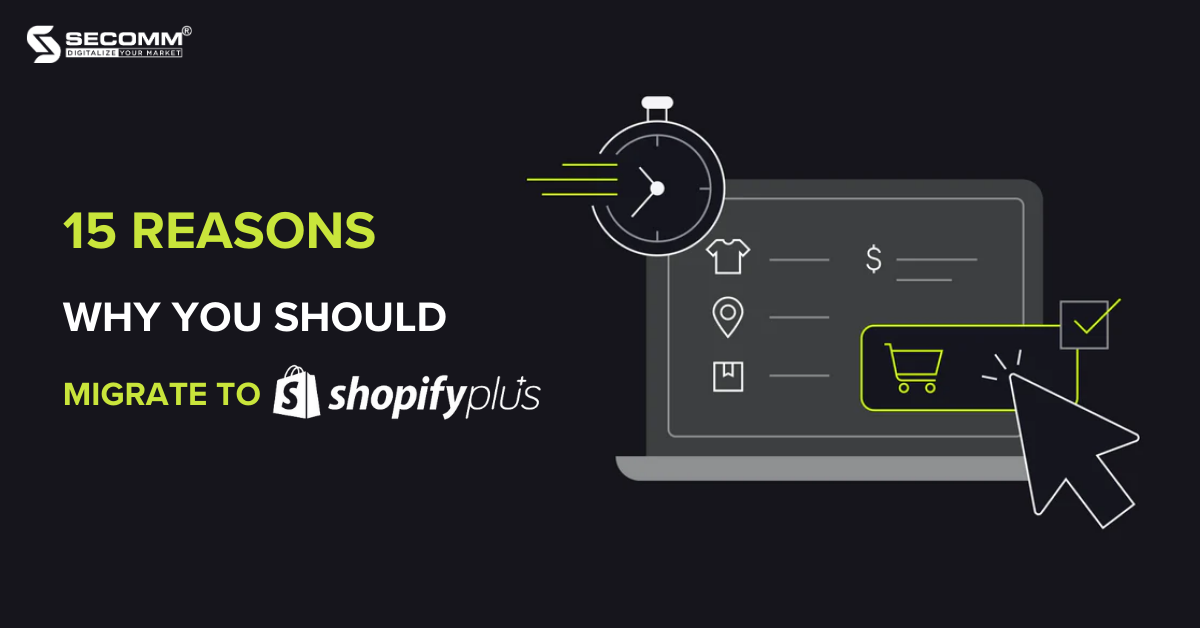
According to the Deloitte 2022 Retail Industry Outlook, up to 67% of businesses acknowledge that the eCommerce platform is their top investment priority due to issues they face with deploying outdated platforms.
Plus, a survey by Digital Commerce 360 revealed that about 27% of businesses are trying to switch their eCommerce platforms despite the associated costs.
Among the myriad of leading platforms today, Shopify Plus stands out as a perfect choice for businesses when deciding to re-platform.
This article will show you 15 reasons why you should migrate to Shopify Plus. Why the platform gains the attention of business leaders and how it can be the key to your development and success in today’s eCommerce landscape.
It is a premium solution of the popular eCommerce platform – Shopify. This version is specifically designed to meet the needs of large businesses with a high investment budget for eCommerce.
It offers flexibility, scalability, and integration, not only helping efficiently build and run an eCommerce website but also providing advanced tools and features to optimize the customer shopping experience.
Here are 15 notable advantages that the platform offers for your business growth, laying the groundwork for you to consider migrating to Shopify Plus.
The dashboard interface is designed to be intuitive and user-friendly, catering to end-users and administrators who directly manage the Shopify store. The intuitive interface allows you to concentrate on developing business strategies and enhancing the customer experience, minimizing the learning curve on how to use the system.
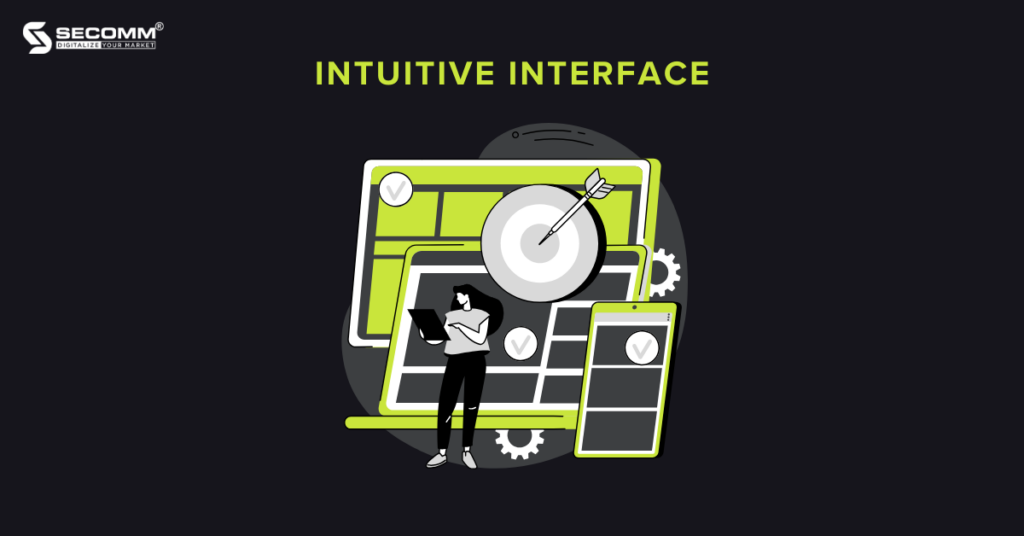
The second reason to migrate to Shopify Plus is the transparency in estimating and managing deployment costs. Typically, when using this platform, you may consider platform fees, transaction fees, app and add-on fees.
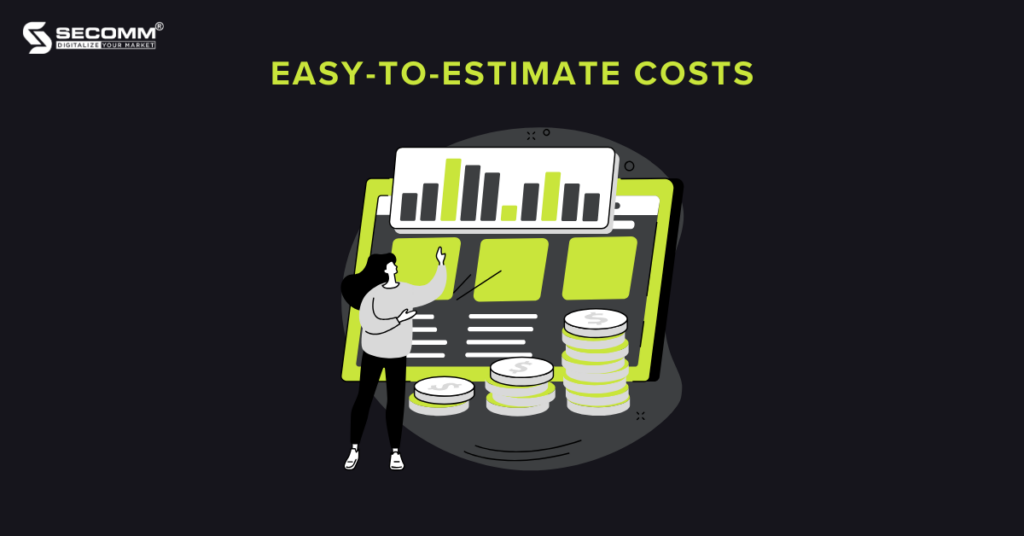
The Shopify Plus pricing system is clear and understandable, helping you know all the fees you need to pay monthly. This helps financial planning, avoiding unexpected fees during the deployment process.
Plus, if you partner with highly specialized technical development teams like SECOMM, we’ll conduct a detailed analysis and propose a phased deployment plan for the Shopify Plus eCommerce website. This approach allows you to gain clarity on how your system will be deployed at each stage, facilitating easy adjustments and flexible optimization of financial resources.
Another advantage of Shopify Plus is the automation feature. The platform provides two exclusive tools to help you facilitate this process: Shopify Flow and LaunchPad.
These automation tools help enhance efficiency and save time by streamlining various processes, allowing you to focus on strategic aspects of your operations.
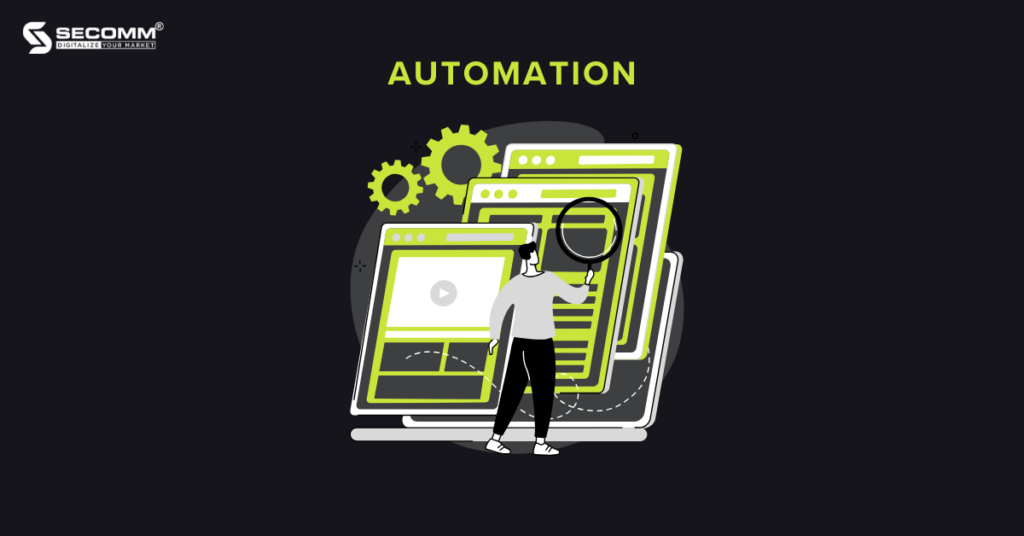
Shopify Plus allows you to reach a broader audience through various sales channels, spanning from offline to online, including leveraging social media for sales and implementing B2B business models.
Plus, you can integrate the Shopify POS solution into their offline stores to offer services such as BOPIS (Buy Online, Pick Up In-Store) and BORIS (Buy Online, Return In-Store). This allows customers to shop in the manner that suits them, combining both online and in-store shopping experiences.
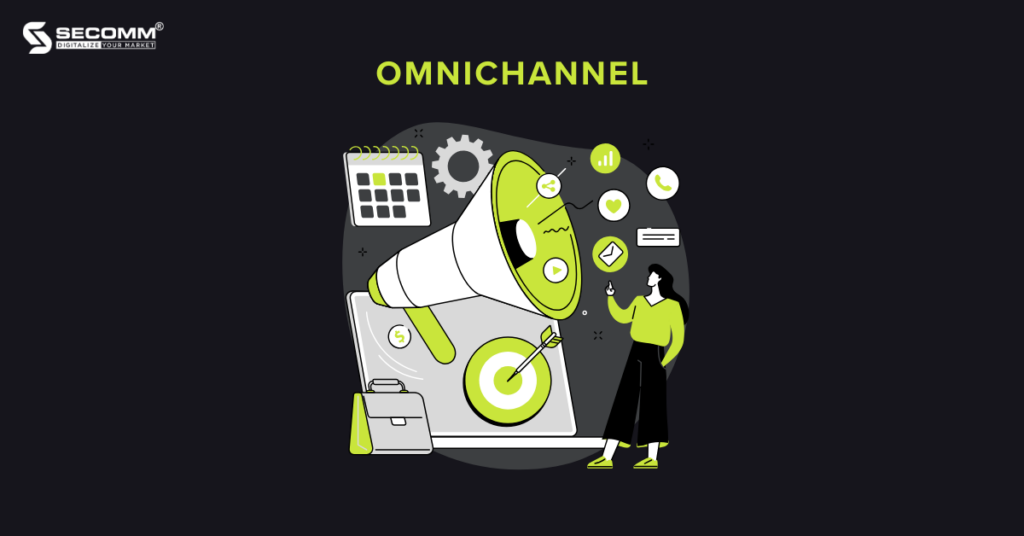
In 2021, Shopify introduced a comprehensive cross-border selling solution called Shopify Markets. With Shopify Markets, you can easily customize their stores for each specific target market. This includes setting prices, languages, payment methods, and delivery options to align with the preferences of local customers.
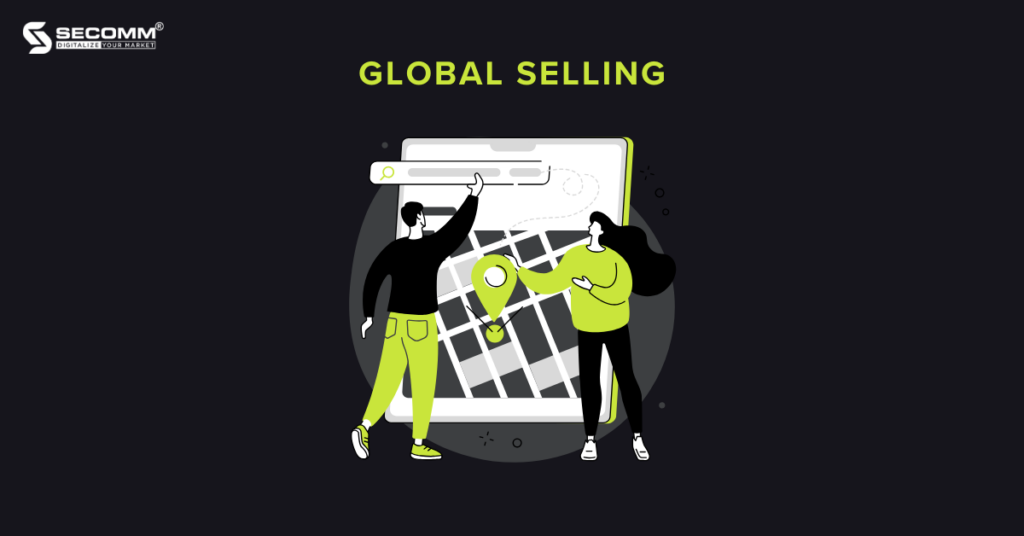
The robust customization is another reason for businesses to switch to Shopify Plus. This platform allows you to freely customize from the frontend to the backend without being constrained by any limits. In particular, you can easily customize the backend with Shopify Functions and Function APIs. Some use cases for Shopify Functions include:
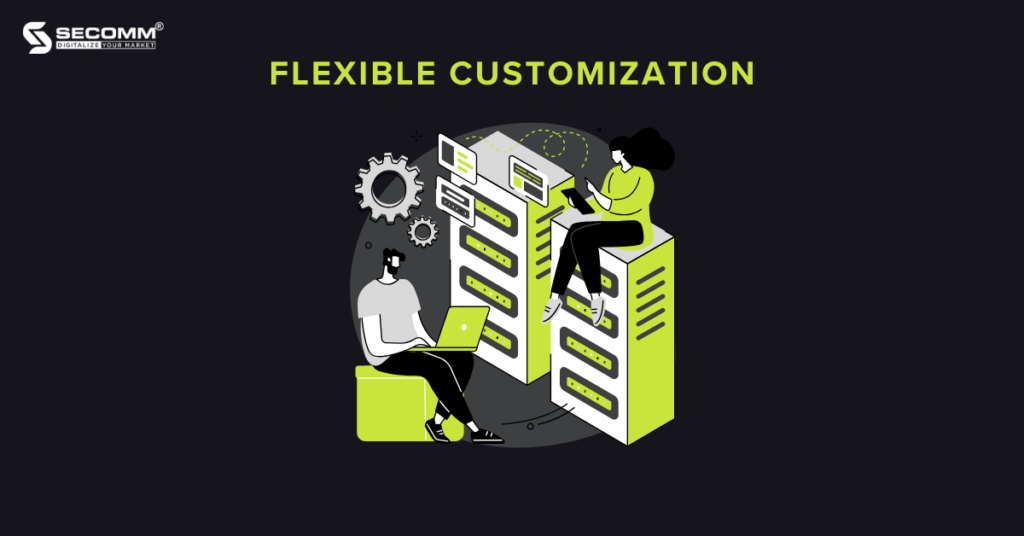
With the popularity of Shopify and Shopify Plus globally, it’s not surprising that Shopify owns a host of useful applications, some of which are specifically developed for businesses deploying Shopify Plus. Moreover, the ‘Plus’ provides diverse documentation and resources (Shopify Plus Certified App Program) for developers to create applications and extensions, contributing to the vast ecosystem of Shopify applications.
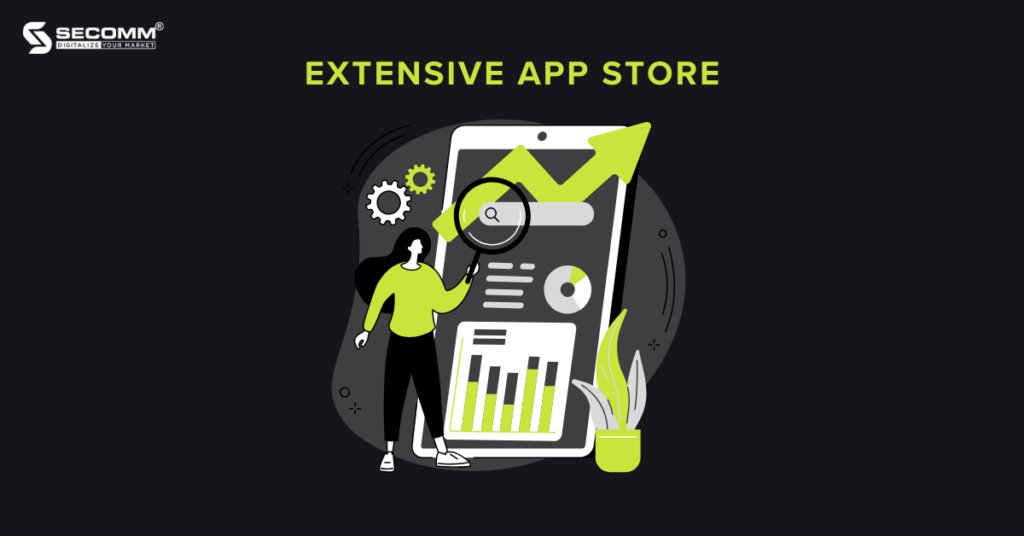
Beyond integrating with solutions within Shopify, you can also integrate with third-party systems such as:

Shopify’s cloud infrastructure can cater to over 600,000 merchants and process speeds of up to 80,000 requests per second during peak periods. This system is built on a dedicated server cluster running Docker and utilizes Rails applications, alongside integrated additional features based on the AWS platform.
Therefore, Shopify Plus can provide powerful processing speed not only for the website but also during the checkout process. It can handle a massive number of visits while maintaining speed and ensuring a positive customer experience, processing over 10,000 orders per minute.
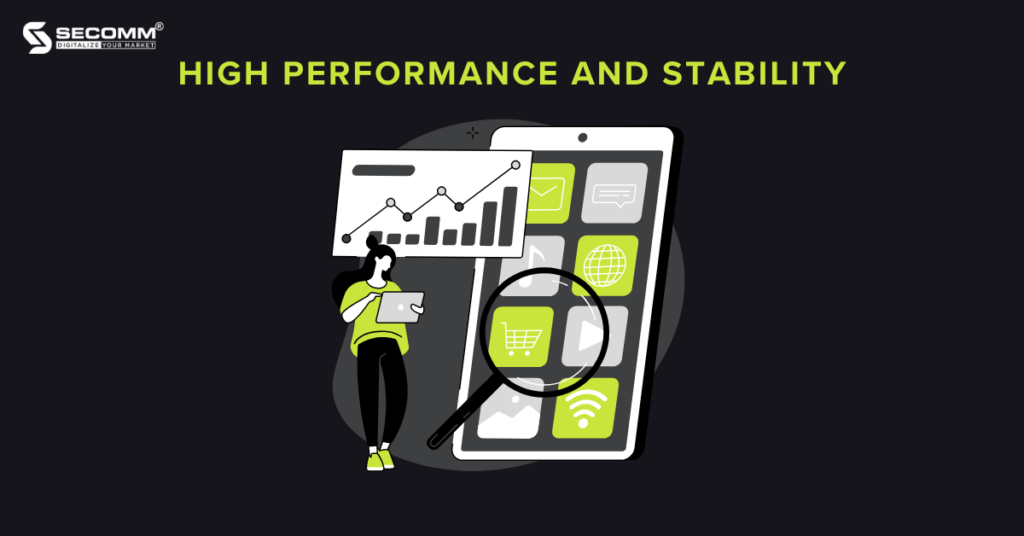
With unlimited bandwidth and flexible infrastructure, Shopify Plus can effortlessly scale to manage increased traffic during peak shopping seasons such as Black Friday, Cyber Monday, and Christmas. This enables you to handle high volumes of customers during peak times without concerns about technical issues or website disruptions.
The flexible customization of Shopify Plus also extends to providing maximum support for deploying Headless Commerce. Moreover, in 2021, the platform introduced the Hydrogen solution – an outstanding tech stack that can meet the highest requirements for building a Headless Commerce system.
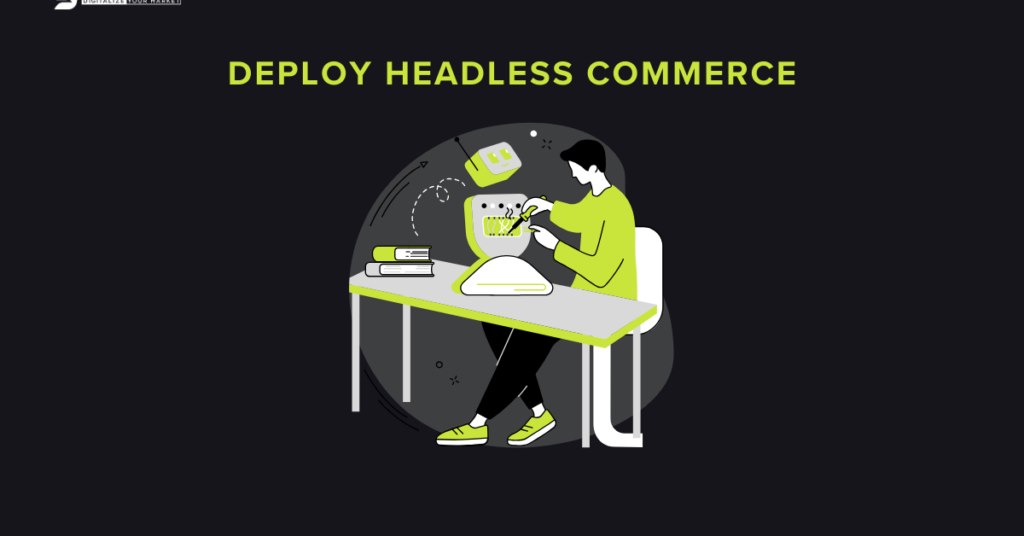
As the demand for flexibility and scalability continues to rise, alongside Headless Commerce, large businesses worldwide are increasingly focusing on the Composable Commerce model. Fortunately, Shopify is keenly attuned to customer needs and has recently introduced the Commerce Components by Shopify solution in early 2023.
As of the time of writing, Shopify stands as the first SaaS platform to provide a tech stack that can address nearly all the development needs of Composable Commerce.
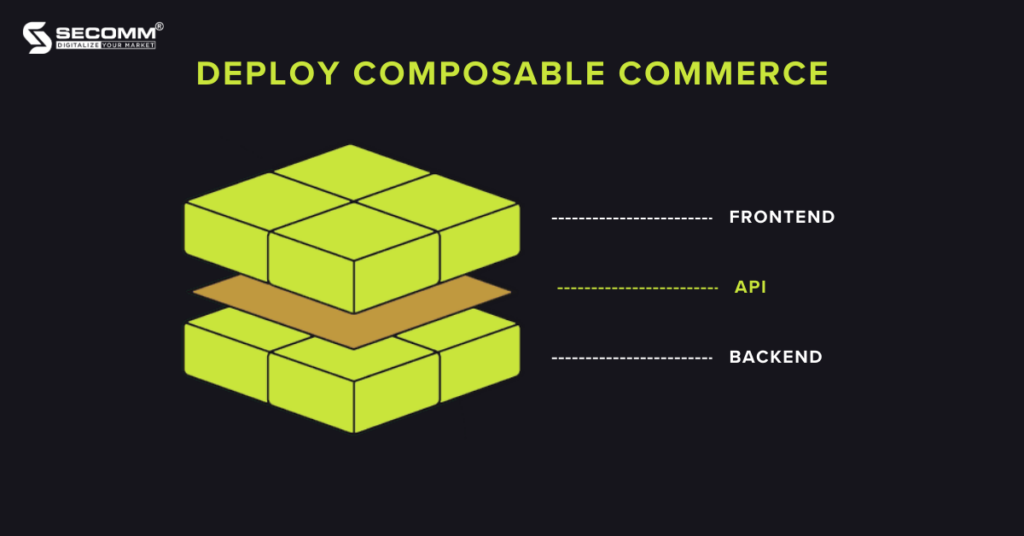
While you may require considerable time to tailor your Shopify Plus store to your specific needs, the nature of SaaS ensures that the go-live process for Shopify Plus remains quicker compared to open-source platforms like Magento.
On average, the deployment and go-live time for the Shopify Plus platform is around 2-5 months, whereas with Magento, businesses take from 6-12 months to deploy and go live.
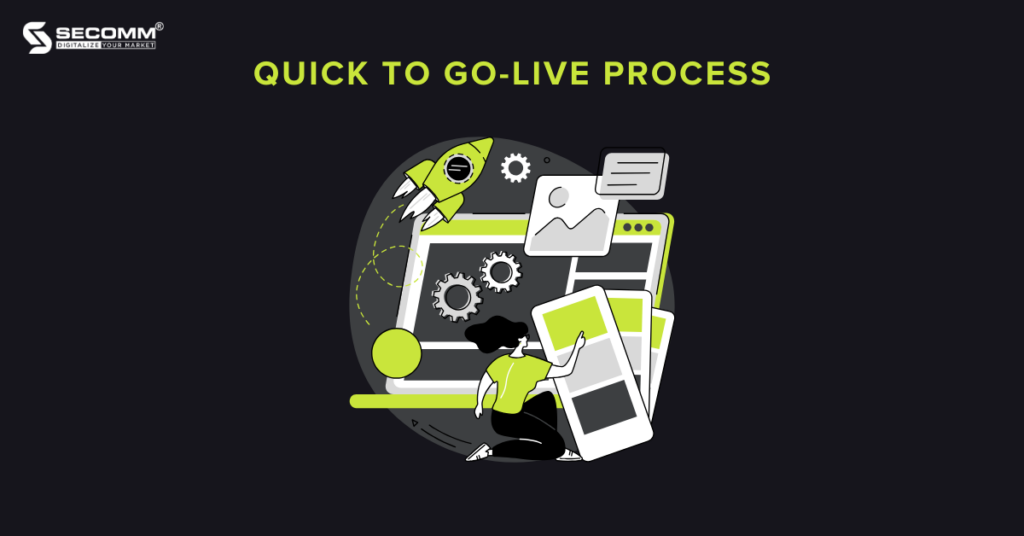
Shopify Plus provides a range of security measures and features to ensure that business data, customer information, and payment transactions are safeguarded to the highest extent possible. This includes:
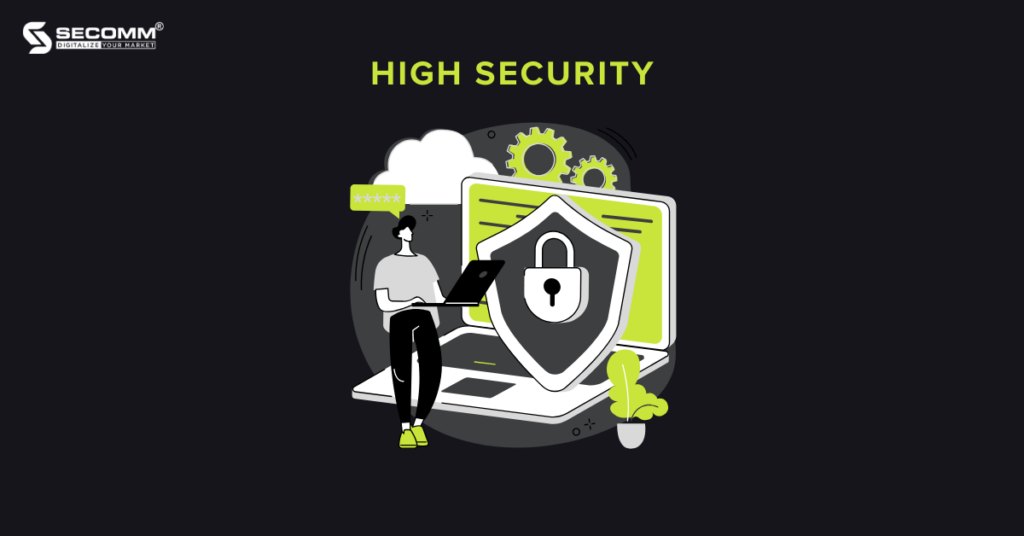
Similar to other eCommerce platforms, Shopify Plus provides businesses with 24/7 support through hotlines, emails, and video calls in various languages. Additionally, this platform offers instructional materials, API documentation, and the Shopify Plus Merchant Success program where businesses can access:
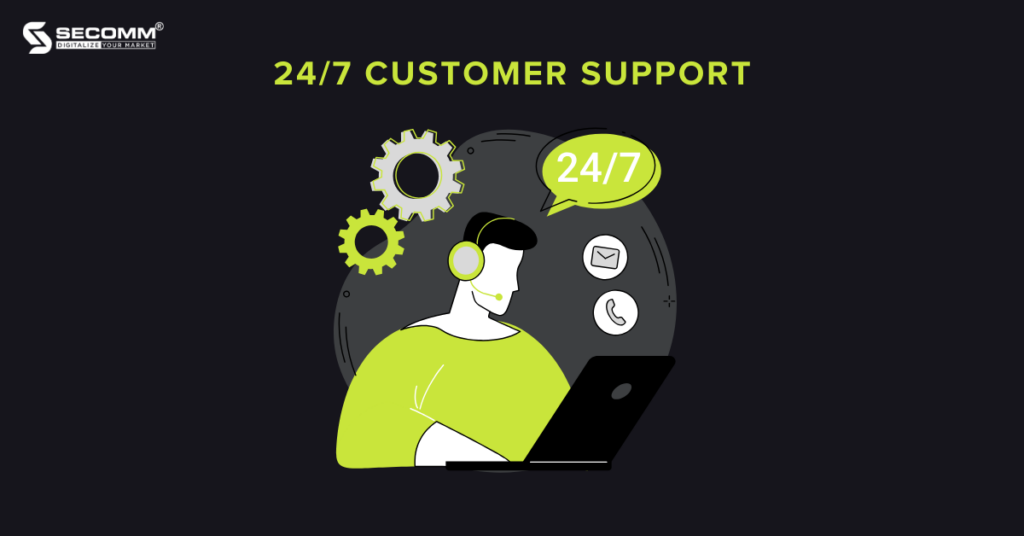
Shopify Plus has a vast and diverse user ecosystem, including businesses, developers, and marketing experts. With numerous leading global businesses choosing Shopify Plus as a key tool to drive their growth and success, it is undoubtedly a testament to the excellence of this platform.
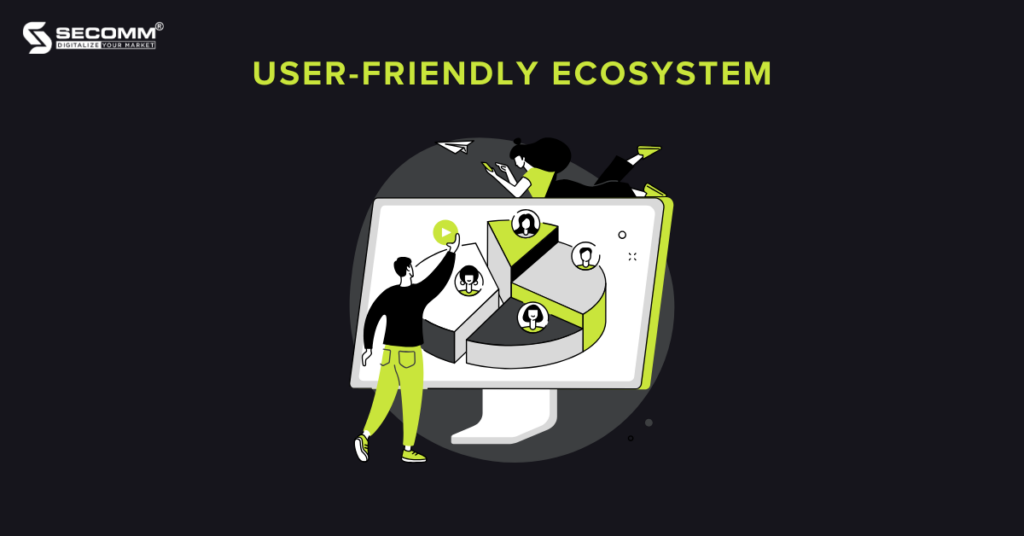
Renowned names such as Gymshark, Glossier, MZ Wallace, and Emma Bridgewater have leveraged the power of Shopify Plus to create customized shopping experiences, expand sales volumes, and reach a broader customer base. Their presence has added another reason encouraging you to switch to Shopify Plus.
With flexible customization, scalability, and support from a reliable team of experts, the decision to deploy eCommerce with Shopify Plus or migrate from another platform to Shopify Plus has been right for sustained and competitive growth in the eCommerce landscape.
Contact SECOMM or call the hotline at 028 7108 9908 for advice and support to swiftly and effectively switch to Shopify Plus.
 2
2
 6,202
6,202
 0
0
 1
1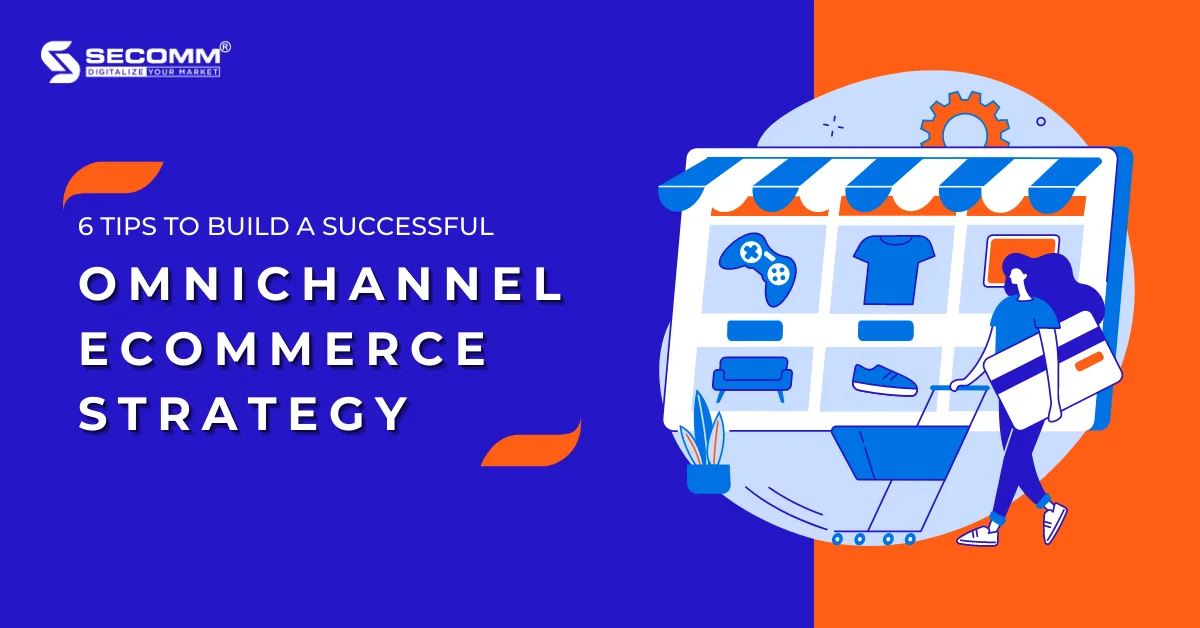
In 2021, The Vietnamese eCommerce market size reached 13.7 billion USD, which means the industry is growing rapidly and playing an important role in Vietnam’s economy.
It forces business owners to find ways to make their businesses stand out and connect with customers.
One of the effective approaches is to implement an Omnichannel eCommerce strategy. This is a marketing method aimed at providing a consistent customer experience across multiple channels. It may be confused with Multichannel eCommerce, where brands sell on various channels but provide different customer experiences on each channel. Although customers can shop on social media, eCommerce websites, physical stores, etc, their experience across these channels could not be seamless. There is also the Single-channel eCommerce model, where a brand only uses one channel for sales.
Retailers globally recognize the potential and impact of Omnichannel eCommerce on their business operations. According to Report Linker, the market for multi-channel retail platforms reached 5 billion USD in 2020 and is projected to reach 14.5 billion USD in 2027. Industry analysts and experts also emphasize that Omnichannel is the future of eCommerce and is a great way to attract customers and provide them with true value.
Here are 6 tips to help you, as a business successfully build an Omnichannel eCommerce strategy.
Tip number 1, regardless of any business strategy, you have to know who your target customers are and their shopping behavior. You can start by gathering relevant data about demographic information, purchase history, etc from various sources, including eCommerce websites, social media platforms, physical stores, etc. Then, you will analyze how they interact with the brand across different channels and create detailed buyer personas.
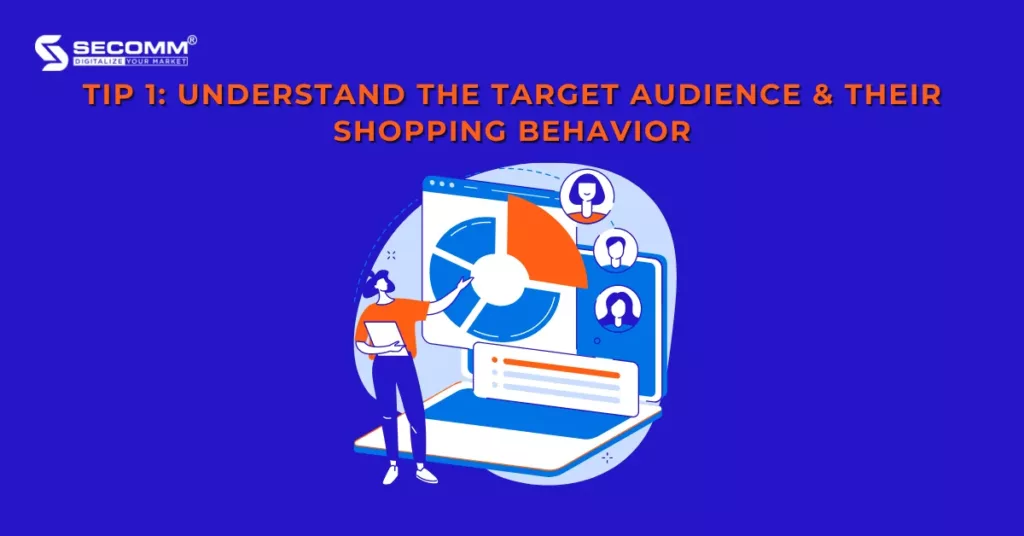
This helps identify effective approaches for each customer segment and tailor messages for each channel. For example, if a significant portion of your customers prefers shopping on mobile devices, you can optimize your suitable marketing campaigns alongside improving the website to attract more customers. Or, you can invest in developing mobile applications to enrich the customer shopping experience and drive conversions.
Tip number 2 is to map out the customer journey to visually understand the process that a potential customer goes through when interacting with your brand. It helps you clearly understand their needs, buying motivations, and so forth. When developing an Omnichannel eCommerce strategy, mapping the customer journey allows you to proactively provide personalized customer experiences across channels. It not only enhances cross-selling, and upselling but also improves customer intention and loyalty.
There are typically 5 stages in the customer journey: Awareness, Interest, Purchase, Retention, and Advocacy.
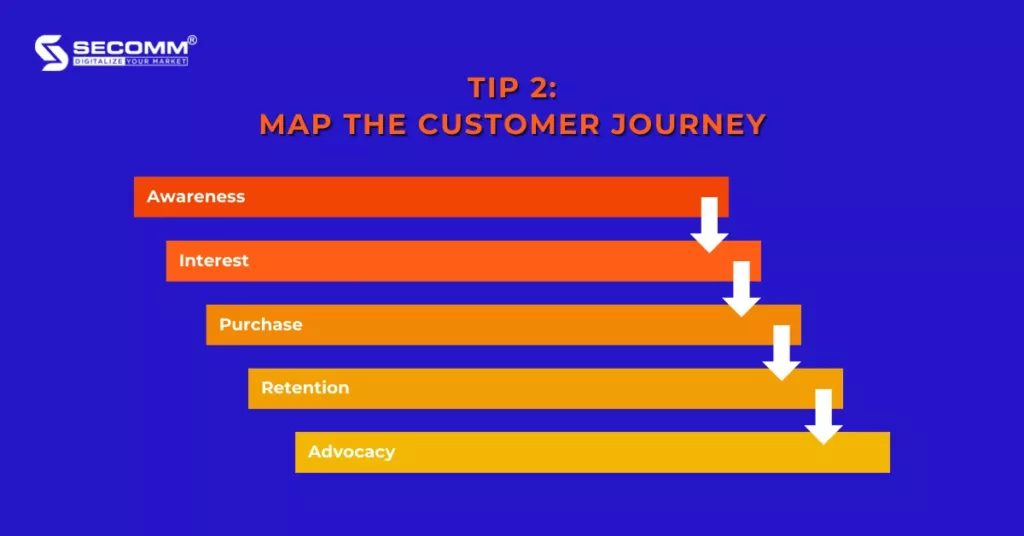
Here are the basic steps to create a customer journey map:
Another valuable tip is to develop a consistent brand message and image across channels. It requires you first to identify and understand the brand values, vision, and mission. For example, you can use consistent elements such as colors, fonts, etc, to help customers easily recognize your brand. Moreover, you need to train your staff on the brand message and image to ensure they understand and communicate the message properly across all channels.
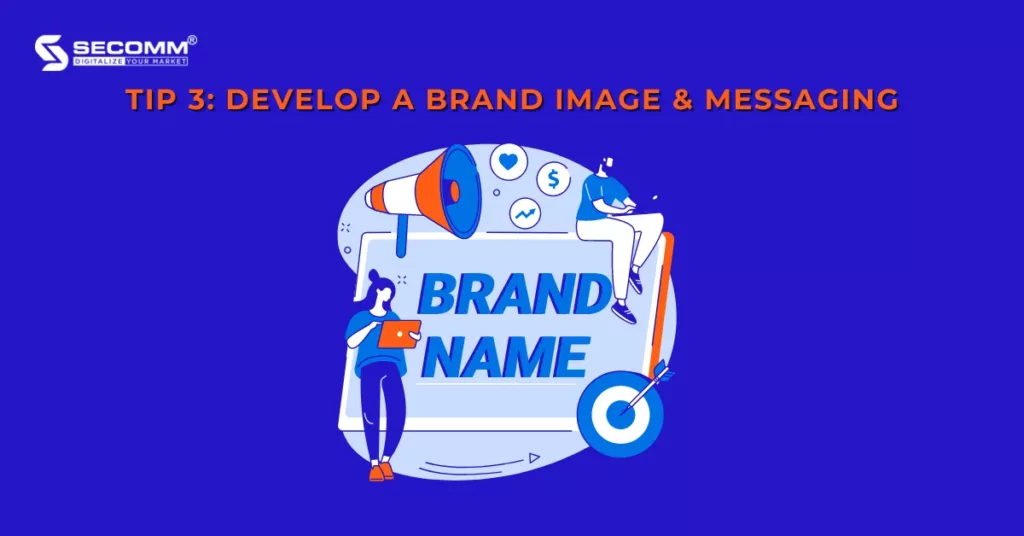
This tip not only helps increase brand recognition and customer loyalty but also creates a seamless customer experience.
Next, you can incorporate social media into your Omnichannel eCommerce strategy and focus on engaging with customers on social media platforms alongside other effective marketing channels. With over 3.6 billion social media users globally, building your brand presence in these places is no longer an option but an imperative measure to effectively connect your brand with customers.
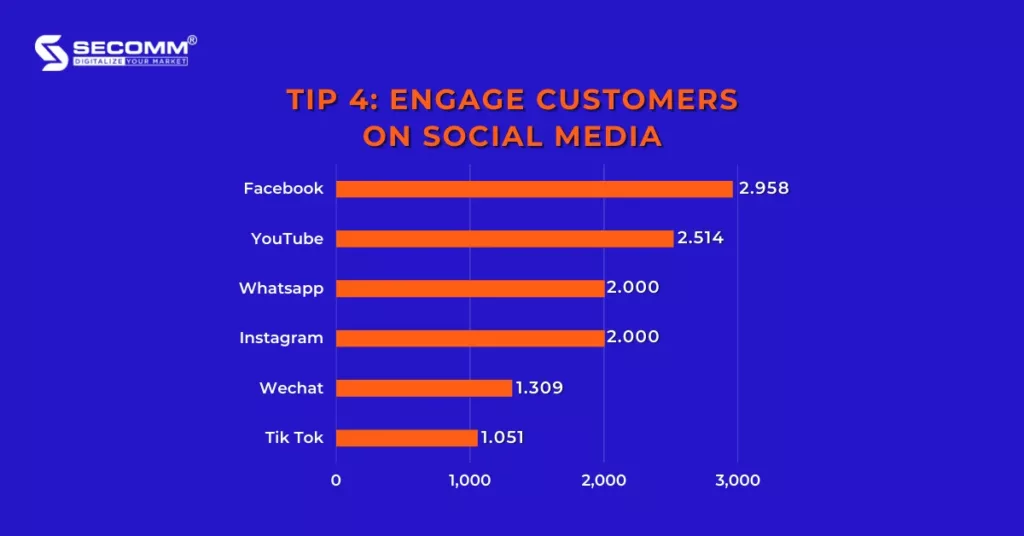
Leveraging social media enables you to engage with customers by responding to inquiries and addressing concerns through messaging or interactions on the news feed in a friendly and approachable manner. In addition, social media provides you with great space to deliver brand messages and voices to customers in a quicker and more intimate way to enhance brand awareness. You can create your own ideas and content or collaborate with influencers.
To tightly integrate social media with other channels in the Omnichannel eCommerce strategy, you can, for example, encourage users to like, comment, and share posts to receive attractive discount codes for purchases on websites or physical stores.
Tip number 5, for a seamless omnichannel experience, you need to ensure that customers can make purchases through any channel they interact with, such as eCommerce websites, marketplaces, social media platforms, and physical stores.
Additionally, to keep up with mobile commerce trends, you should optimize mobile-friendly and responsive websites as well as user-friendly mobile apps for easy navigation and usage.
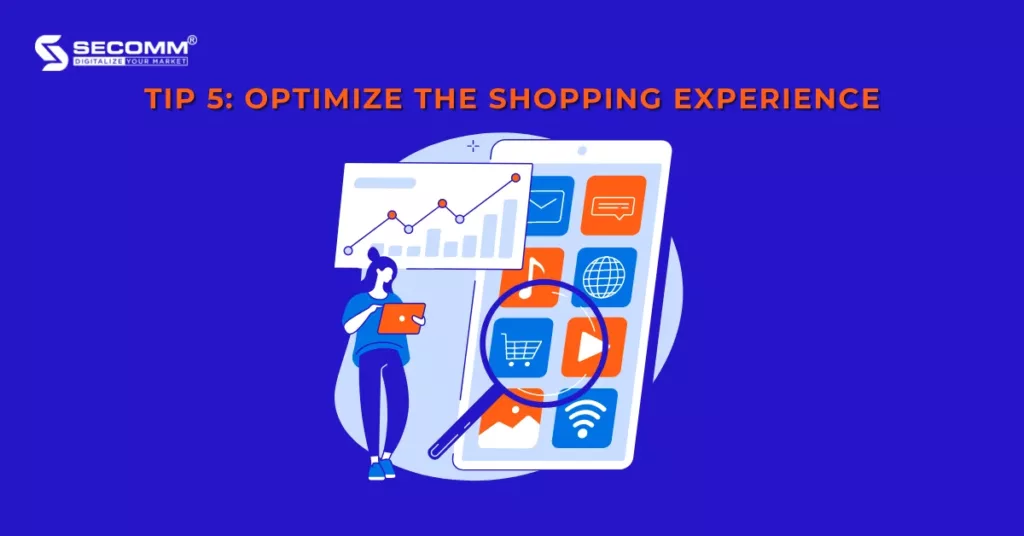
Since Omnichannel eCommerce emphasizes consistent experiences across all channels, content and customer-related information such as login credentials, payment details, and shopping carts should be synchronized. This enables customers to move seamlessly between channels and devices while preserving the items in their shopping carts or without the need to spend time logging in or re-entering payment information. Moreover, you can leverage data analytics to personalize product recommendations for each customer, displaying relevant or complementary products based on their behavior and purchase history across channels to increase cross-selling and upselling opportunities.
Tip number 6 is measuring and analyzing the results of the strategy. During the implementation process, you can utilize data analysis tools such as Google Analytics, Google Tag Manager, Facebook Pixel, and others to check, track and analyze customers across all channels. It helps identify which channels generate the most traffic, level of engagement, and sales revenue, and identify areas for improvement. In addition, you can gather customer feedback to enhance and optimize your strategy. The work should be conducted to make appropriate adjustments and achieve desired results.
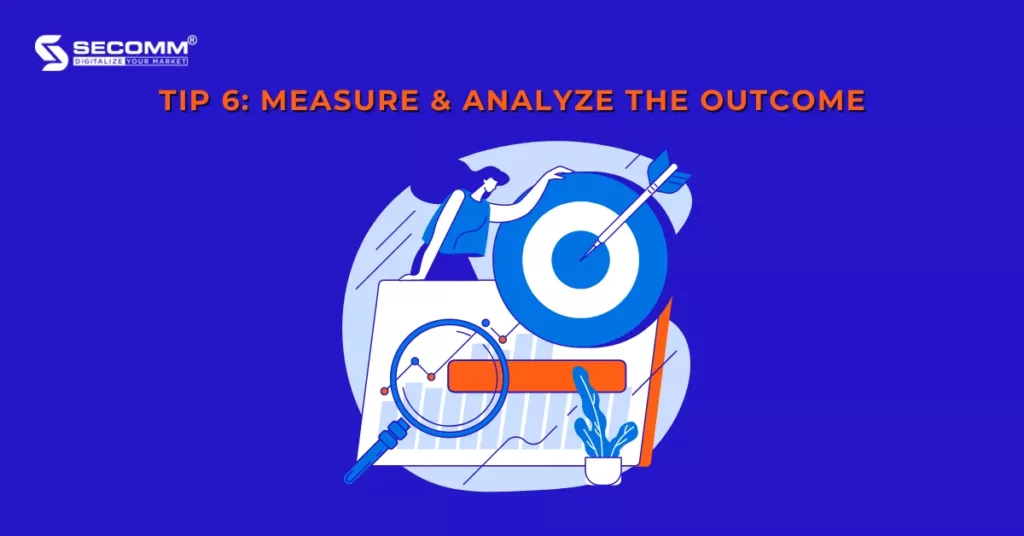
Contact SECOMM now for a consultation on building an Omnichannel eCommerce strategy.
 2
2
 8,082
8,082
 0
0
 1
1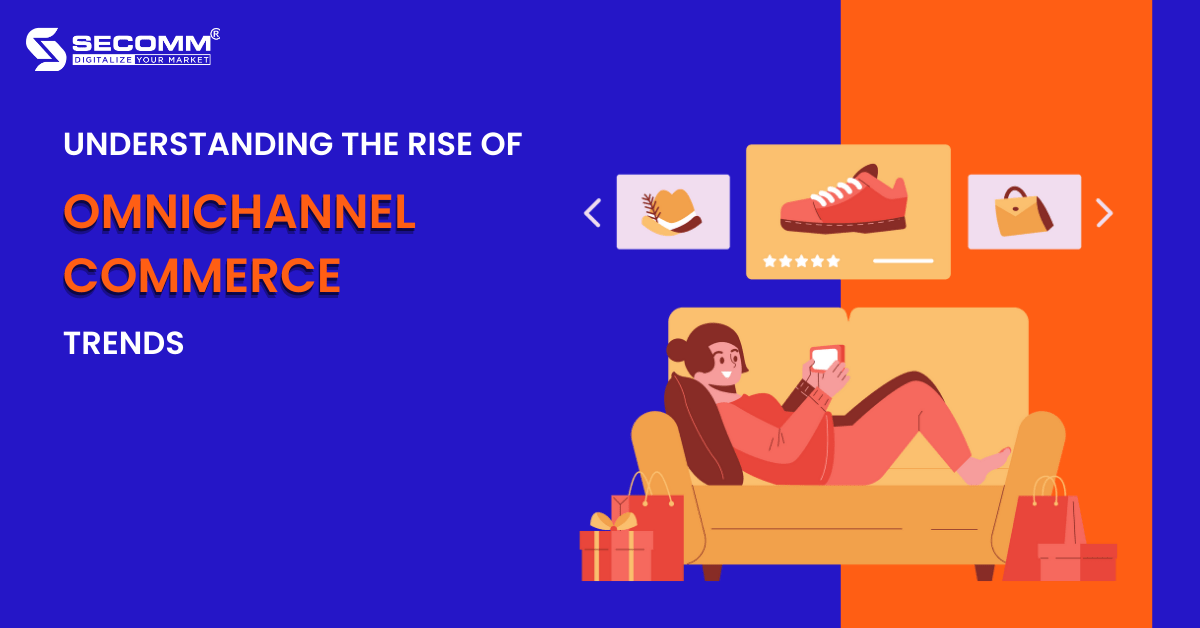
We are living in a world where the younger generation has taken the lead in setting ever-rising standards for digital experience. So, it’s important for businesses to quickly adapt to new trends for sustainable development to keep up with the shift.
Especially during a global pandemic, eCommerce has become one of the top priorities of every business owner. In order to thrive in a rapidly changing market and keep customers loyal, brick-and-mortar businesses have had to build an online presence and increase their eCommerce capabilities.
The term “Omnichannel Commerce” is defined as a “trend” that helps businesses achieve the aforementioned objectives and this trend is expected to continue to accelerate in the coming years.
Omnichannel Commerce is a multichannel approach that focuses on offering a seamless shopping experience by marketing and selling across all channels where potential customers are present including mobile devices, social networks, eCommerce websites, and brick-and-mortar stores.
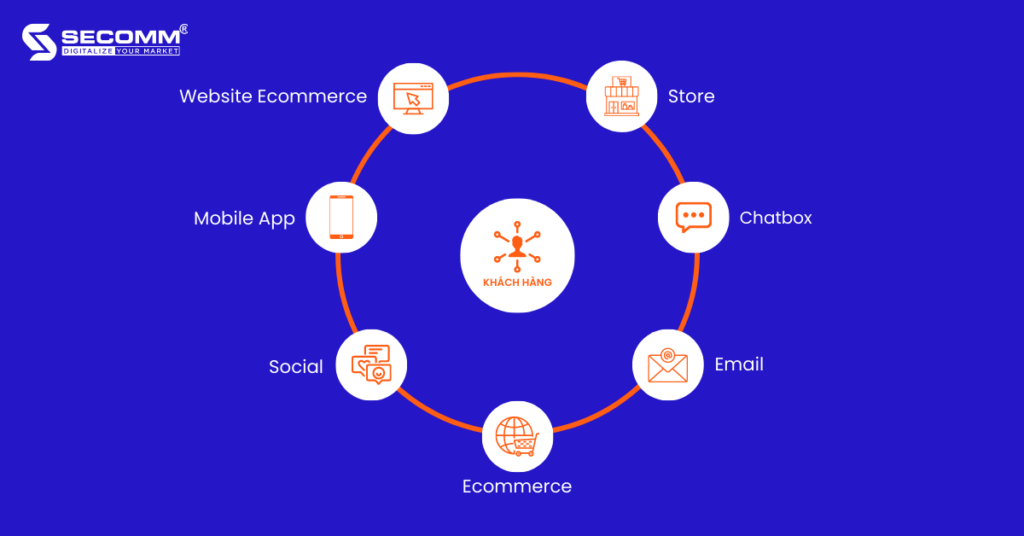
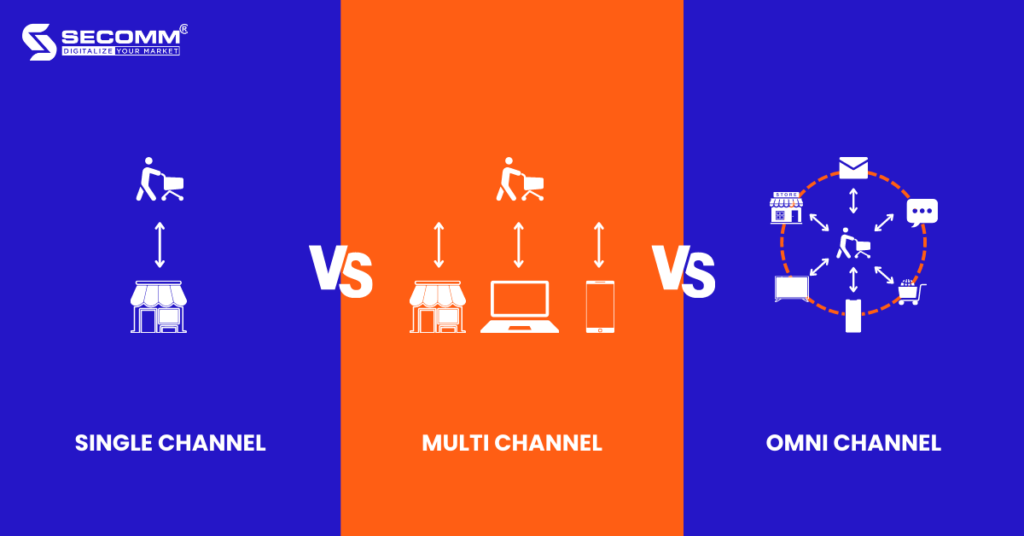
When a company sells its products or services only through one channel, that approach is known as single-channel commerce. It could be a physical store, an eCommerce website, or a marketplace like Shopee, Lazada, Tiki, etc.
Selling through a single channel could initially be quite successful, but if businesses desire to provide their customers with a richer shopping experience and increase brand awareness, they need to add multiple channels to showcase and sell their products or services.
When it comes to the Multichannel Commerce strategy, businesses will interact with customers and sell their products through both online and offline channels. This strategy makes use of touchpoints where customers can perform the same action at any available channel. These touchpoints, however, are independent and barely or not at all connected among channels. For example, a physical store with an eCommerce website has no inventory-sharing function.
Similar to Multichannel Commerce, Omnichannel Commerce enables a company’s marketing and sales efforts to be spread across numerous channels. The main distinction is that Omnichannel Commerce prioritizes the customer, connects all touchpoints, and creates a unified buying experience. But, Multichannel Commerce aims to reach as many channels as possible, with unique content for each and customers will interact with brands through their preferred channels.
An effective Omnichannel Commerce strategy includes effective operations of each sales channel that will be integrated in a seamless and consistent manner. Touchpoints should provide a unique but connected experience based on previous interactions. That experience takes customers to the end of the customer journey to get the business’s objectives.
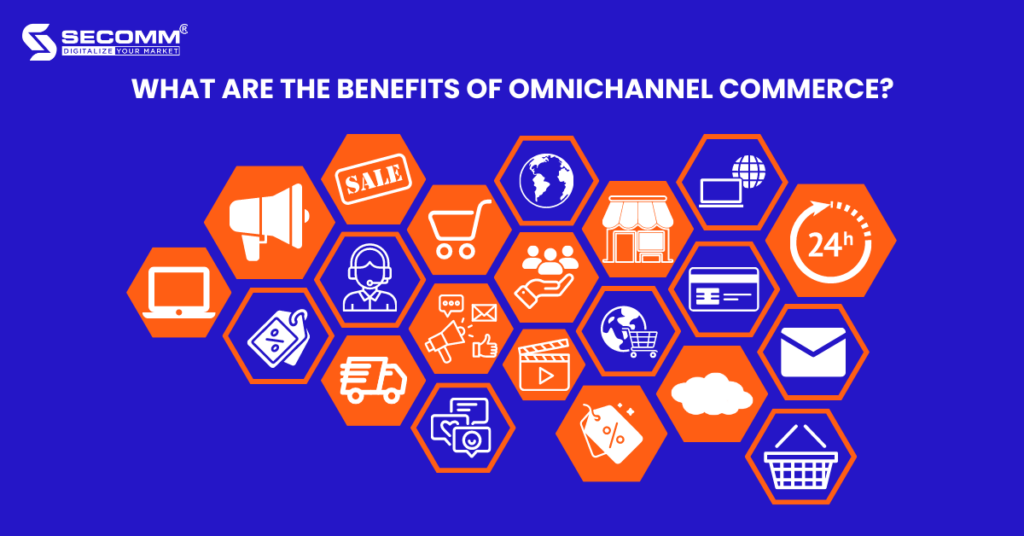
Imagine a man who wanted to buy a new washing machine. After seeing an attractive TVC with the merchant’s information, he used his laptop to begin searching on the Internet. He discovered the merchant’s eCommerce website, and his desired product is offered at a local physical store. He decided to add that product to his shopping cart after chatting with the customer service team.
He downloaded the merchant’s app, signed into his account, and accessed his cart before heading to the store because he wanted to see and check that washing machine in person before making a purchase. He checked the app to ensure the item is still in stock, its quantity, the best payment method, and any associated special offers.
When he arrived, he checked the product’s quality and checked out with the QR Code. The transaction is finished. Under the CRM system, his information and data would be saved for upcoming marketing campaigns and post-sale efforts.
Nowadays, consumers receive a ton of offers and messages from many brands day after day. This brings up many considerations when choosing a brand to engage with. Developing an Omnichannel strategy to connect with customers in a seamless manner across multiple channels will set a brand apart from the competition.
Omnichannel Commerce is a customer-centric model, connecting touchpoints and providing personalized experiences. This contributes to the company’s revenue increase as expected with cross-sell and up-sell opportunities.
Also, the branding strategy will be effective and successful, enhancing customer loyalty as well as the brand message will reach the right target audience thanks to the consistency of the Omnichannel Commerce model. It’s not only useful for increasing customer engagement but also for customer data evaluation.
Thus, businesses will have a bigger picture of the customer journey, the times and channels customers usually interact with, as well as the most effective and valuable marketing campaigns. All this data needs to be meticulously analyzed and reused in the next marketing campaigns.

Omnichannel Commerce has long been a strength for Nordstrom. They created the Pincode feature that allows customers to use their smartphone to scan and access Pinterest to get a $100 Nordstrom giveaway while in the store. The brand also showcases in the store Pinterest’s best-selling products as an interesting suggestion.
In addition to Pinterest, it uses Youtube to create video tutorials for matching outfits and suggests its customers go to the physical store to meet a professional. At the store, they will receive valuable advice that may lead to a purchase decision.
Recently, Nordstrom has leveraged Instagram’s shoppable posts to inspire shopping and encourage customers to make quick decisions.

Sephora is one of the major brands in the beauty industry that is successful with Omnichannel Commerce. The company has established a strong connection between online and offline shopping experiences. Customers can access Sephora Beauty Bag’s personal account by using available tablets in its brick-and-mortar stores.
This account allows them to look up details of the items they are interested in and try them out using virtual reality. Additionally, Sephora’s benefits, like its in-store makeup tutorials and personalized gifts, have encouraged customers to make larger purchases.

The world-famous beverage brand – Starbucks has launched the Starbucks Rewards App which is considered the pinnacle of Omnichannel Commerce. After creating an account, Starbucks fans can find a list of local stores, order drinks, and pay in advance so they don’t have to wait in line.
The app also regularly makes personalized recommendations for each customer based on previous orders, loyalty programs, weather, holiday seasons, or local store inventory.
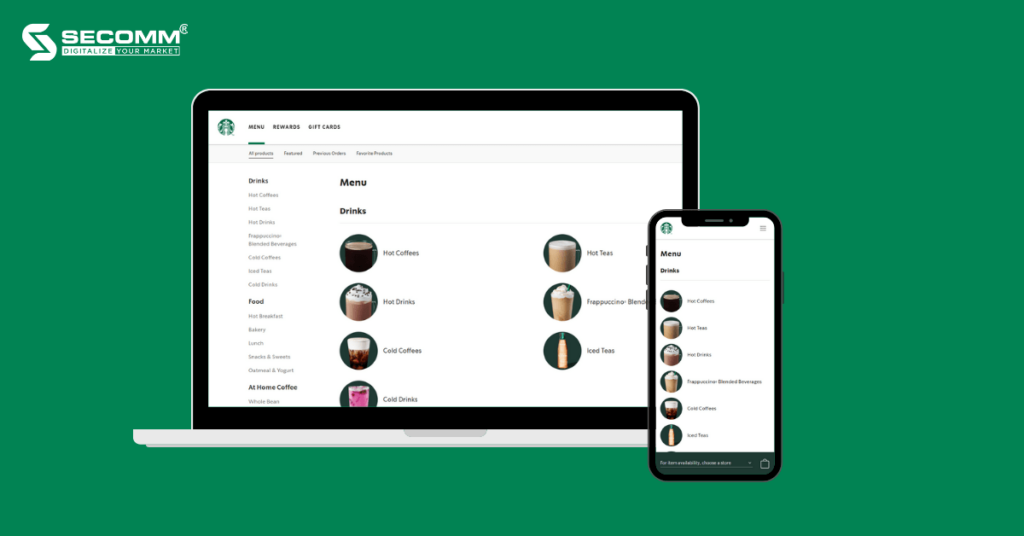
Keeping up with the ever-changing business world is not easy. In fact, many big brands in the world have implemented Omnichannel Commerce early and have achieved great success. Plus, many other businesses are tending to gradually shift from Single-channel or Multichannel to Omnichannel and recognize this model as a bridge connecting customer experience between online and offline channels in a seamless way.
With many years of experience in successfully implementing eCommerce for many customers in many countries, SECOMM understands the difficulties when doing an Omnichannel Commerce strategy.
Contact our expert now to get a free consultation.
 2
2
 3,647
3,647
 0
0
 1
1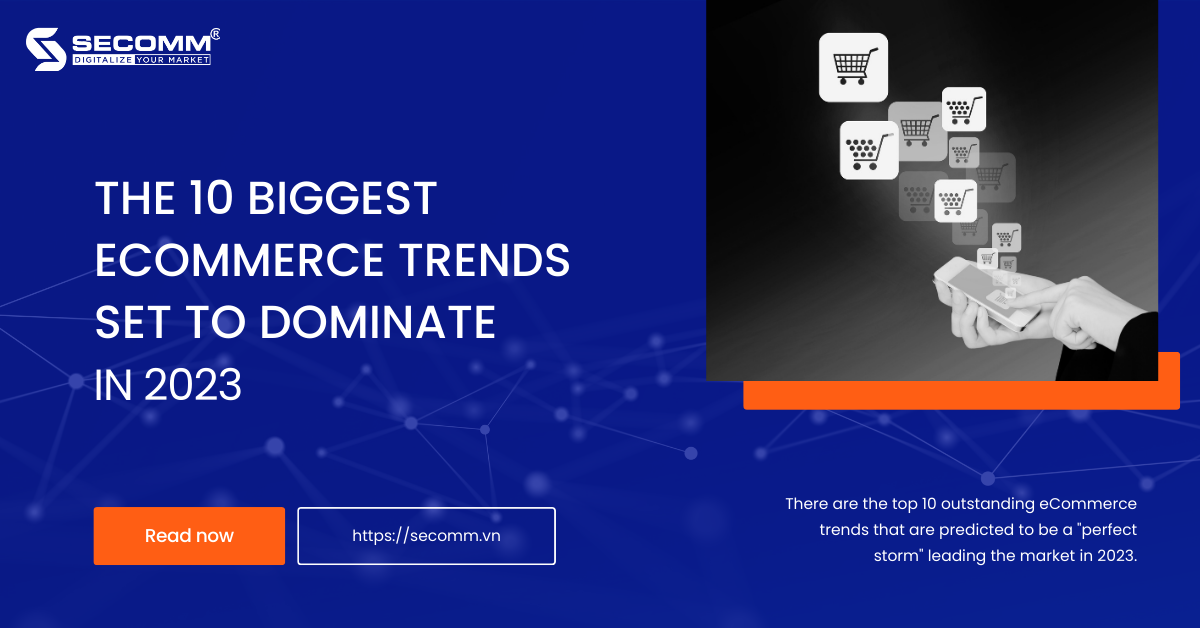
The eCommerce industry has a sizable market share in the Vietnamese economy and has shown impressive growth over the past two years due to the effects of the worldwide pandemic and social isolation.
After a year of society adjusting to the “new normal”, customers have started to buy at traditional stores again but the established trend of eCommerce consumption and the push from the wave of global digital transformation have encouraged businesses to change in order to suit the way the digital economy works.
Therefore, recognizing and anticipating the eCommerce trend of 2023 is extremely necessary for businesses’ New Year’s Marketing strategies to be implemented effectively and successfully.
Below is a list of 10 eCommerce trends that are forecast to “storm” the market in the next year.
Omnichannel is an omnichannel sales model that helps businesses reach customers through many channels such as eCommerce websites, social networks, eCommerce platforms, chain stores, and distribution agents but operating in just one management system.
Additionally, there is a second type of sales model called “Multi-channel” that differs from Omnichannel in that it allows for discrete marketing content, unlinked data, and independent channel operation.
When purchasing across numerous channels, continuous and seamless updates result in a heterogeneous and seamless customer experience.

Due to the lifting of social distance restrictions, consumers are beginning to return to in-store buying after two years of online shopping.
However, that doesn’t mean that eCommerce’s growth momentum is stagnant; on the contrary, it keeps exploding.
Businesses there make use of the current rise in popularity of online shopping to encourage the use of Omnichannel to improve the varied and efficient shopping experience.
As researchers have noted:
As a result, 2023 will still be recognized as a strong year for omnichannel in eCommerce.
Mobile Commerce or mCommerce is a business model that allows companies and individuals to deliver goods and services directly to consumers through handheld wireless devices such as smartphones and tablets.
According to Bankmycell, the number of smartphone users worldwide in 2022 is 6.648 billion, equivalent to 83.07% of the world population owning a smartphone.
Moreover, it is predicted that this number will increase to 7,516 billion by 2026. In addition, the percentage of global users participating in online shopping in 2022 accounts for 58.4%.
In Vietnam alone, interesting figures are listed in the Vietnam eCommerce White Book in 2022:
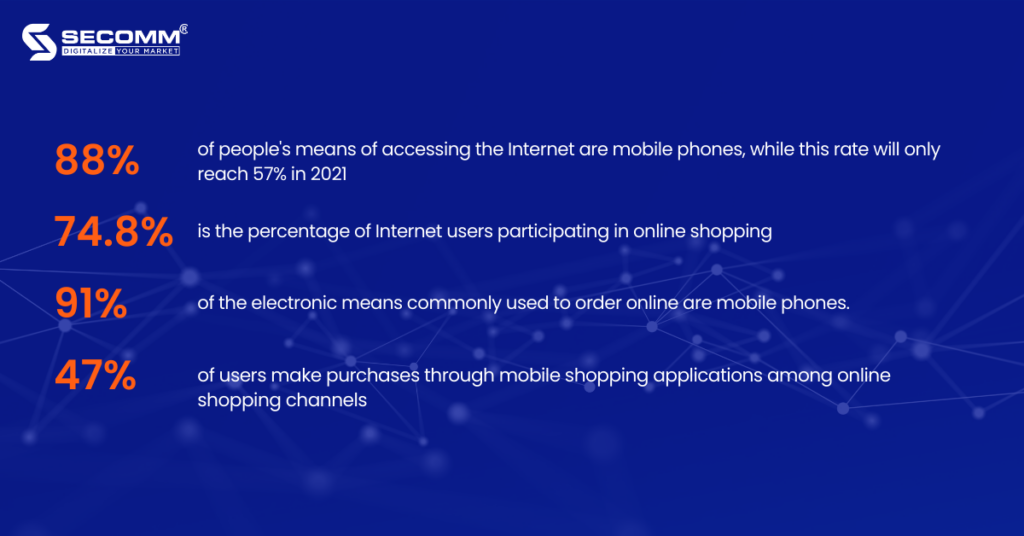
In upcoming years, the percentage of global people and Vietnamese people as well who own mobile devices and use them for online shopping is high and predicted to increase significantly.
Social commerce refers to the method through which companies advertise and sell goods and services online using social networking sites like Facebook, Instagram, TikTok, Youtube, Zalo, etc. In other words, this type of business combines eCommerce and social media.
The impact of social networks has grown significantly in recent years. Over 59% of the world’s population uses social media, it is not surprising that this percentage will continue to rise.
While in the past businesses used social media to raise brand awareness and draw in new customers, today eCommerce businesses boost sales by offering goods and services to clients online via social media.
As a result, it’s incredibly handy for customers to interact, exchange information, and search and shop online all in one location.
According to Statista, global social commerce sales will reach $992 billion in 2022 and are projected to reach nearly $3 trillion by 2026.
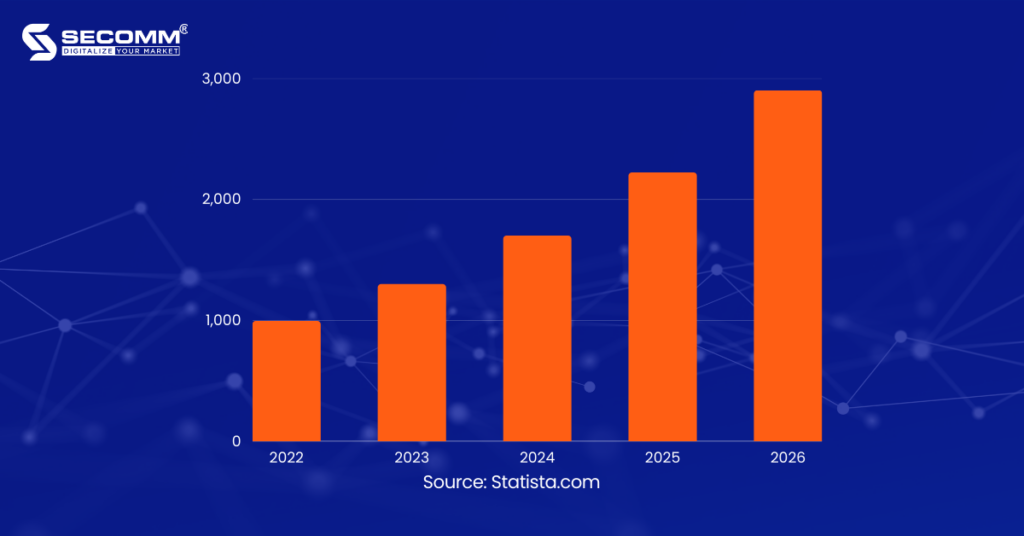
Thanks to the development of social networks, social commerce has had a strong acceleration and has become a magnet for brands to come to approach and analyze a large number of potential customers, and achieve marketing and sales goals.
As a result, failing to prioritize social commerce in enterprises’ marketing strategies in 2023 is probably to lead to a significant loss of competitive advantages in the eCommerce market.
Today, businesses have a lot of choices to build an eCommerce website, but basically, the structure of a website will include the following main parts:
For websites using a traditional structure, the frontend and backend will be operated on the same platform and from there will be closely connected with each other. Therefore, any changes on the website will be edited in two parts at the same time. However, with Headless Commerce, the backend and frontend will be decoupled from each other and operate independently on two separate systems.
The benefits of deploying Headless Commerce:
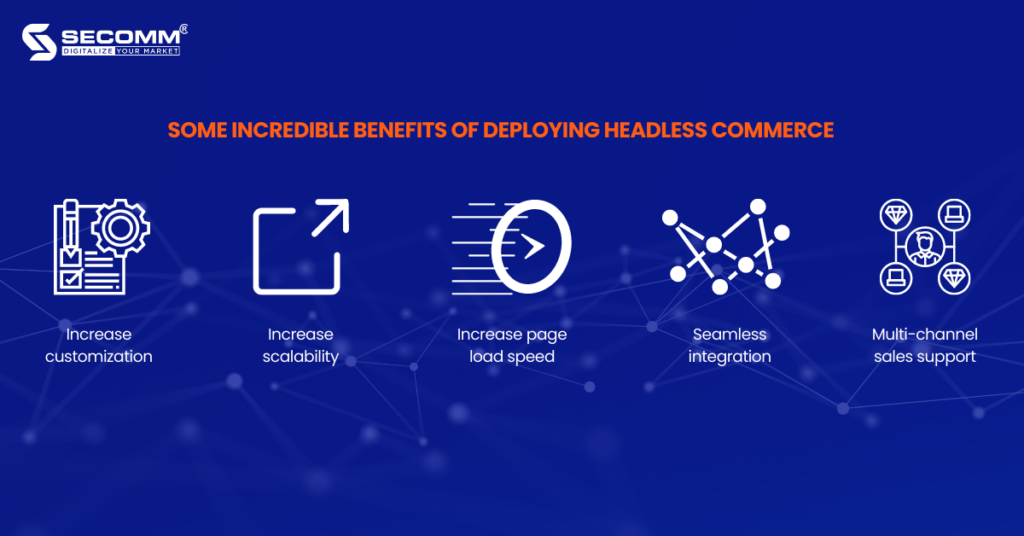
By using the Headless structure, Nike has become a brand with a much larger market share than Adidas – a formidable competitor of Nike.
Moreover, Nike’s website recorded more than 60 million pageviews in just 1 month. In addition, the proportion of direct purchases without intermediaries also increased significantly.
From Nike’s Case Study, one of the practical alternatives for companies looking to encourage eCommerce sales growth is Headless Commerce.
Shoppertainment is a form of shopping combined with entertainment that is used as a marketing strategy to encourage customer engagement with brands and consequently increase shopping demand. Moreover, it is used and takes over most of the online commerce in the era of digital transformation, when eCommerce is positioned at the forefront of contemporary business trends.
Some common practices of Shoppertainment trends:
These three practices all focus on entertainment and interaction. Then, the emotional element is aroused, leading to a series of unwise and unplanned shopping decisions. From a business perspective, this is beneficial for brands. TikTok‘s recent research proves it:
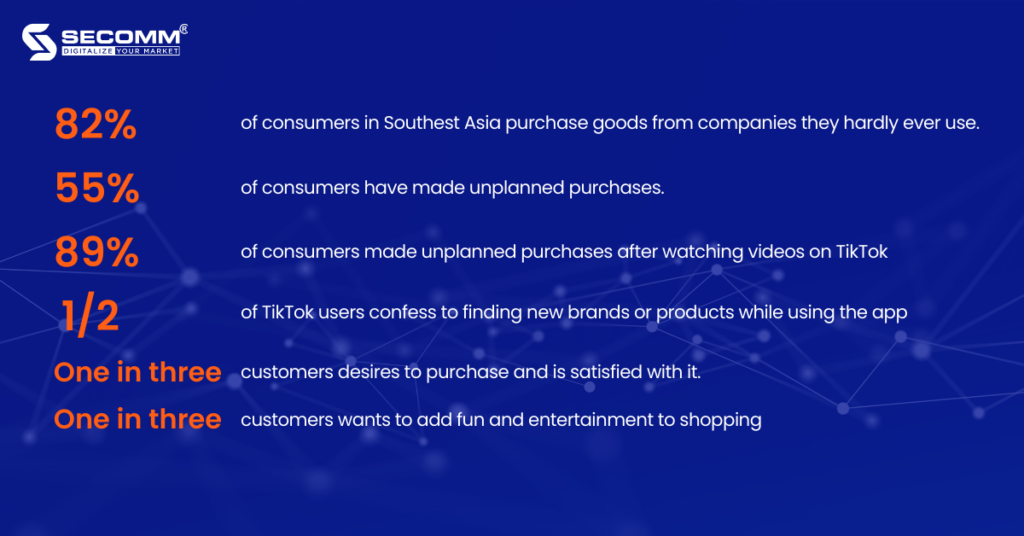
The growth of the Shoppertainment trend in recent years demonstrates the extreme demand for social interaction and connection following the period of Covid’s life.
Shoppertainment is the solution that businesses seek. This is a way to make the most of the customer’s biggest weakness – emotions.
When feelings of euphoria and joy are elicited during the shopping process, customers engage more, and purchase more unplanned products, conversion rates are higher, and sales follow.
Artificial intelligence now has a significant impact on eCommerce businesses in providing solutions to optimize the online shopping experience of customers.
The following statistics demonstrate the incredible influence of AI on the eCommerce market and businesses operating in this field:
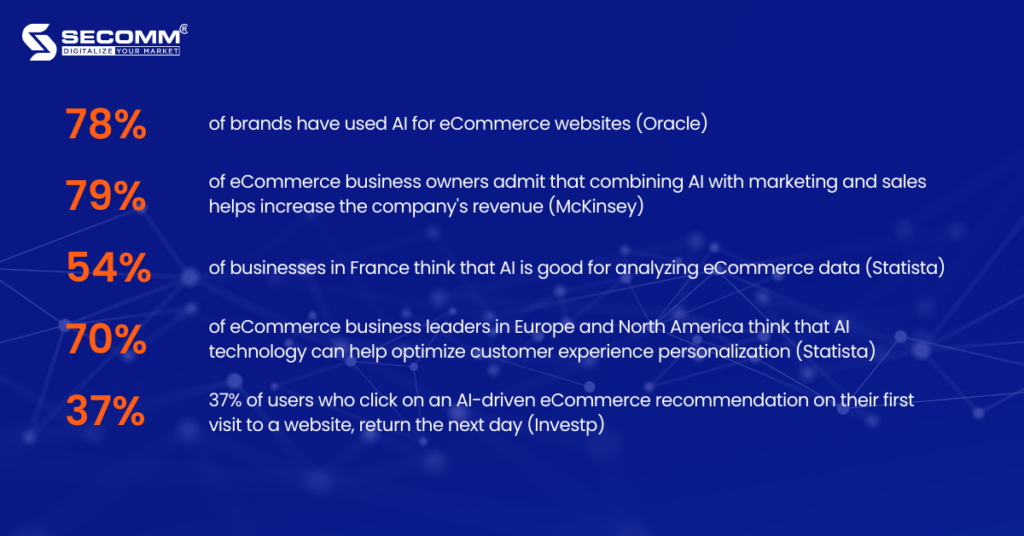
Currently, there are two applications of AI technology that are commonly used in eCommerce:
For eCommerce businesses, Chatbots will be like salespeople who can interact directly with customers 24/7. This helps businesses narrow the distance in terms of geography and time zones, helping the sales and customer services process to take place effectively without interruption.
By collecting customer data, AI can create tailored content and recommendations for each specific customer. To improve marketing campaigns and personalize the customer experience, AI can also predict purchasing behavior based on a user’s browsing and search history, when the data is legally available.
VR (Virtual Reality) is a modern technology that brings users into a simulated but still very realistic space with only 3D glasses (virtual reality glasses). The virtual world that the user sees is actually set up and controlled by a highly configurable computer system.
AR (Augmented Reality) is a new technology enhanced from VR technology. This technology has the potential to erase the boundary between the real world and the virtual 3D model. That is, users will experience virtual models in real space through smartphones or computers.
With a clear plan and the appropriate approach, Lazada has been in front of the augmented reality trend for a number of years and developed a certain competitive advantage in luring both consumers and sellers.
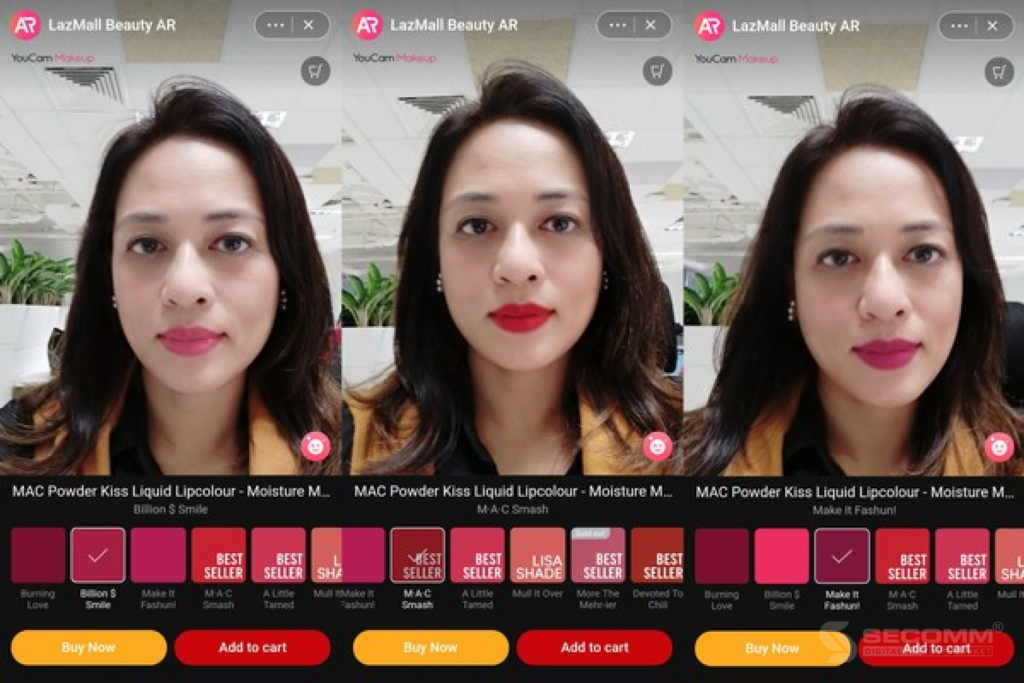
In particular, the VTO (Virtual Try On) function on Lazada includes a wealth of features to assist customers in freely selecting and trying goods like eyeshadow, eyeliner, foundation, and cushions whenever and wherever they like.
Since its launch, LazMall brand partners in the cosmetics sector have experienced tremendous success with the VTO function, which has helped to boost conversion rates by 3.1x and average order values by up to 11%.
The rapid growth of social networks and eCommerce has given marketing efforts a fresh and original breeze thanks to KOL/KOC. Although KOL and KOC have long existed in some form, they have truly taken off in recent years.
KOL – Key opinion leader, also known as an “influencer”, is an individual or organization with expert product knowledge and influence in their field or industry.
KOC – Key Opinion Consumers are “the most influential consumers in the market”. Their job is to test products and services and make comments and reviews.
KOL will suit mid- to high-end brands, while KOC will suit mid-range brands. If KOL is used to select brand ambassadors, holiday season ambassadors, or product launch campaigns, KOC is used to boost sales in a short time or direct customers to websites or eCommerce platforms.
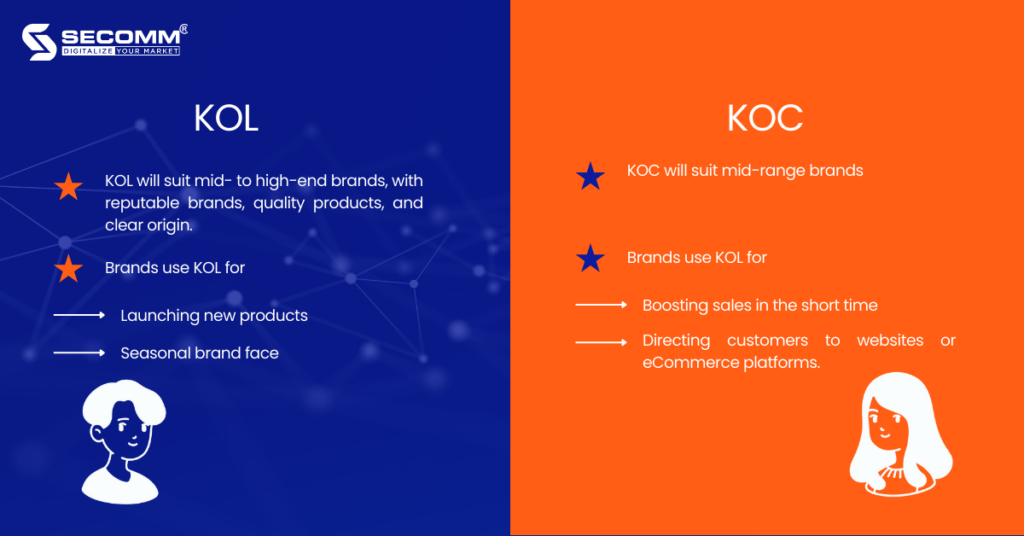
Some famous KOLs in Vietnam: Helly Tong, Giang Oi, Dino Vu, Co em Trendy, Chau Bui, Khanh Vy, Khoai Lang Thang,…
Some famous KOCs in Vietnam: Ha Linh, Call Me Duy, 1m88, Ong Giao Review, Chau Muoi, Hoang Viet, Pu Met 7,…
BOPIS – Buy Online Pick-up In Store is one of the shopping trends that promise to explode in 2023. Customers won’t have to be concerned about shipping costs, extended delivery times, or the risk of receiving unexpected goods when using BOPIS.
Businesses all around the world are pushing up their BOPIS implementation to meet customer expectations when merging online buying with in-person pickup. This is the ideal approach to boost store visits and close the gap between the offline and online buying experiences.
According to GlobeNewswire, the global BOPIS market is projected to reach $703 billion by 2027 with an estimated CARG of 19.3% between 2021-2027.
In addition, the following BOPIS trend statistics can help businesses consider implementing in 2023:
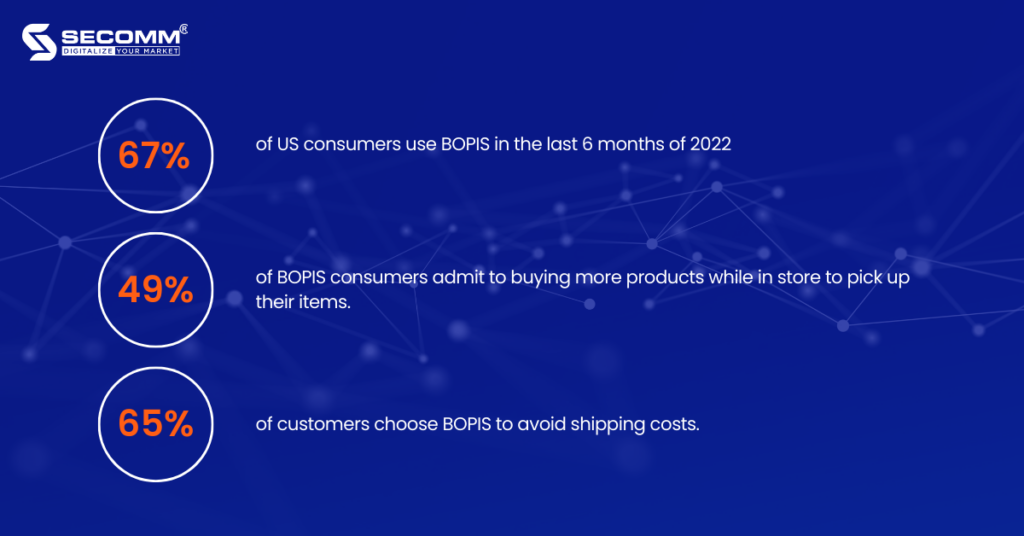
The BOPIS model also aids businesses in cutting expenses, expediting deliveries, boosting demand for retail goods, and lowering the risk of product returns.
User Generated Content, also known as UGC, includes text, photos, video and reviews. Because people are becoming less and less engaged in the brand’s message over the past ten years, UGC has grown in importance.
According to a recent Salesforce survey, 53% of Millennials think user-generated content (UGC) influences their shopping decisions, and 92% of consumers prefer content created by friends and family over that created by brands. The reason for the above numbers is trust.
Therefore, user-generated content (UGC), such as photos, videos, and customer evaluations, is trustworthy social proof and aids in the development of a company’s reputation.
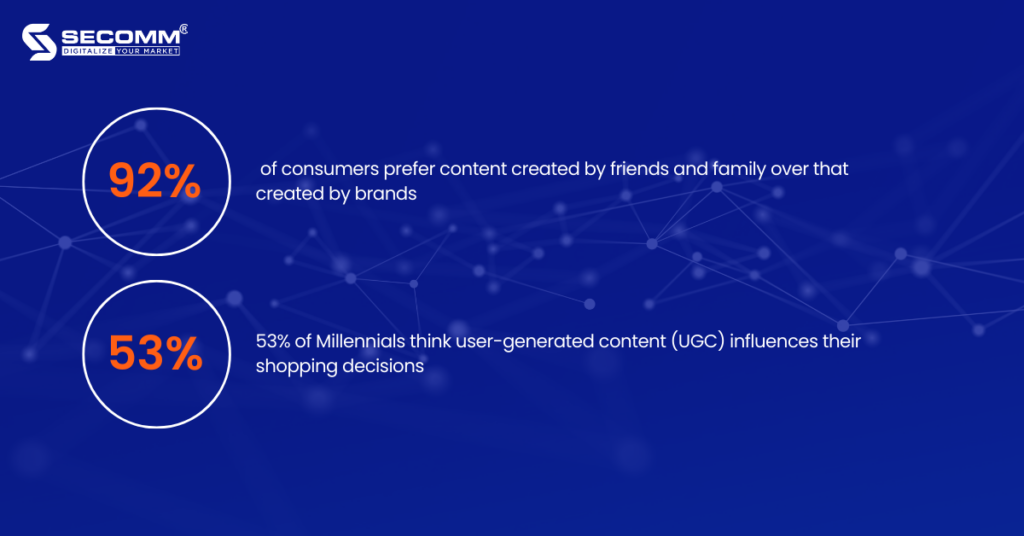
In a nutshell, businesses must quickly adapt to evolving eCommerce and digital technology trends in order to avoid falling behind and being driven out of the market. By reading 10 eCommerce trends that stated and analyzed above, businesses will have an overview to be ready for the new journey.
With many years of experience in successfully implementing eCommerce for many customers in many countries, SECOMM specializes in providing consulting services with comprehensive and professional eCommerce implementation solutions.
Contact SECOMM today for free support and advice.
 2
2
 4,907
4,907
 0
0
 1
1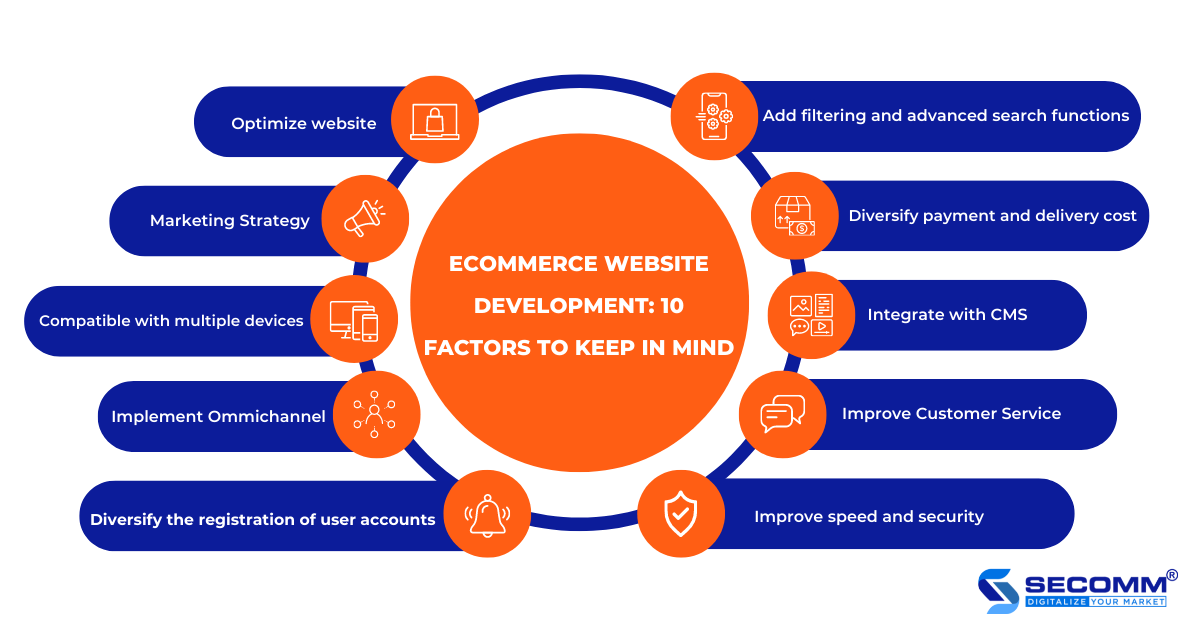
Creating an eCommerce website is a critical step in assisting businesses in spreading their brands and increasing their ability to reach potential customers on the Internet, thereby increasing revenue and profit. However, developing a business website is a complicated process with many aspects, particularly with eCommerce websites.
Businesses must consider everything from user experience to operational performance and many other aspects of the site. Here is a summary of the key factors of an eCommerce website that businesses and website developers should consider before getting started.
According to Think with Google research, if a web page takes up to 5 seconds to load, the likelihood of a user exiting increases by 90%. As a result, businesses must prioritize optimization and ensure that their eCommerce website is always operational.
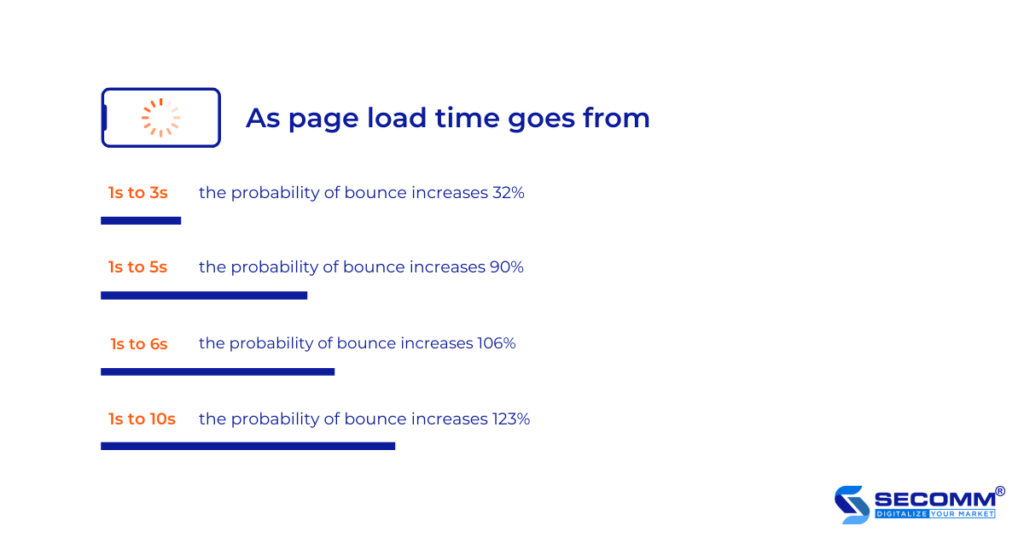
Furthermore, businesses must pay attention to optimizing SEO so that the website has the highest possible ranking on search engines using specific techniques and strategies if they want to maximize revenue on their brand websites. One of them is the strategy of incorporating keywords into the eCommerce website’s content, as well as description, title, and image information.
When adding an “alt text” description to an image, many businesses forget that customers can find their website through image search. This is also a significant flaw that results in a significant loss of potential customers.
Furthermore, in the early stages of e-commerce website deployment, businesses should consider hiring SEO experts. They can launch the website with the necessary meta tags, organize the page structure and internal links, create content strategies, design recommendations for cross-device-friendly functionality, improve page load speed, and many other critical aspects.
A good marketing strategy may benefit the first orders offline and online, particularly in eCommerce. Creating an early marketing strategy assists businesses in identifying the features that must be included in developing eCommerce systems.
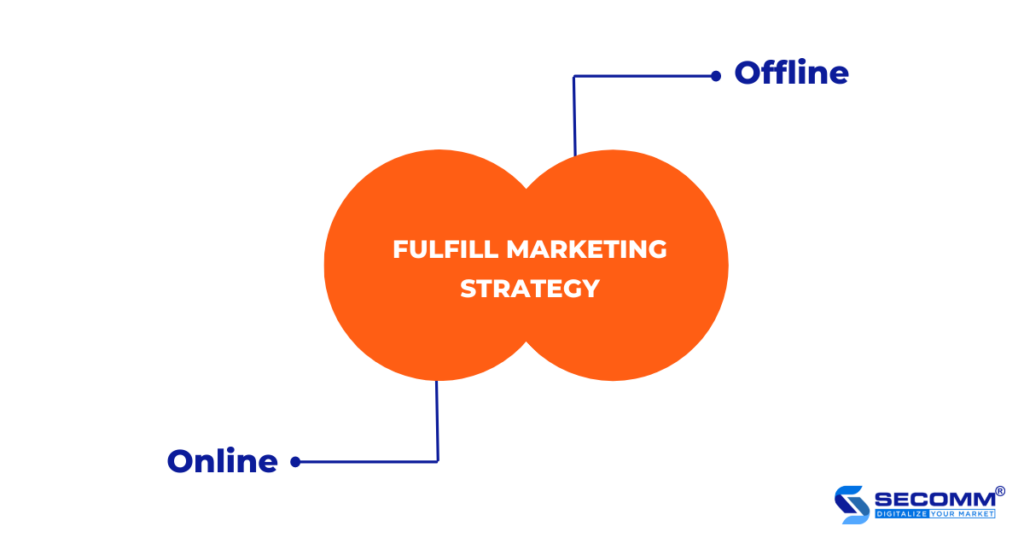
For example, when businesses want to add the option to share a promotion campaign to social networks or push notifications on mobile apps from an eCommerce website, it will be more effective if this is part of the Marketing strategy and is planned to be implemented during the development of the eCommerce website rather than proposed to be developed after the website has been launched.
According to the World Bank, two-thirds of adults worldwide use digital payments, with this figure expected to rise from 35% in 2014 to 57% by 2021. Although users prefer to make purchases via mobile apps, businesses can still increase conversions if the eCommerce interface is easily adaptable to the mobile web.
For example, after releasing a more optimized responsive design, Walmart Canada successfully increased website conversions by 20% and improved mobile order growth by 98%.
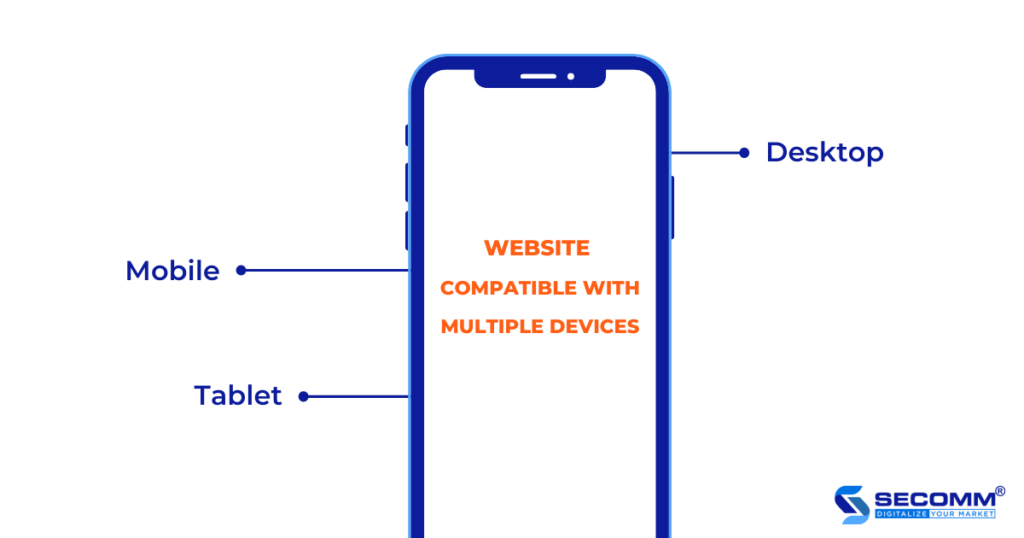
Furthermore, businesses must ensure that customers from all over the world can easily access and shop on their eCommerce website using any available browser.
As a result, businesses will conduct cross-browser testing using Google Chrome, Internet Explorer, Firefox, Opera, Safari, and other browsers to find and fix errors, ensuring customers have a great shopping experience on your website using any browser, any device, and anywhere. Businesses can hire a qualified third party to assist them, or they can conduct their own testing using a few available help tools.
In the digital age, “Omnichannel” is becoming increasingly popular and is an essential communication strategy between businesses and their customers. Every business should adopt an omnichannel strategy to connect with customers, increase traffic, drive sales, and survive the changes of the times.
As a result, implementing Omnichannel enables businesses to synchronize all sales channels for easier data management and increased eCommerce business efficiency. At the same time, Omnichannel provides customers with a seamless experience, allowing businesses to sell omnichannel and increase conversion rates.
When implementing Omnichannel, businesses can use Omnichannel platforms and systems (ETP Group, NEF, GoSELL) or choose one system as the data center for the entire system, such as an eCommerce system (Magento), ERP (Odoo, SAP).
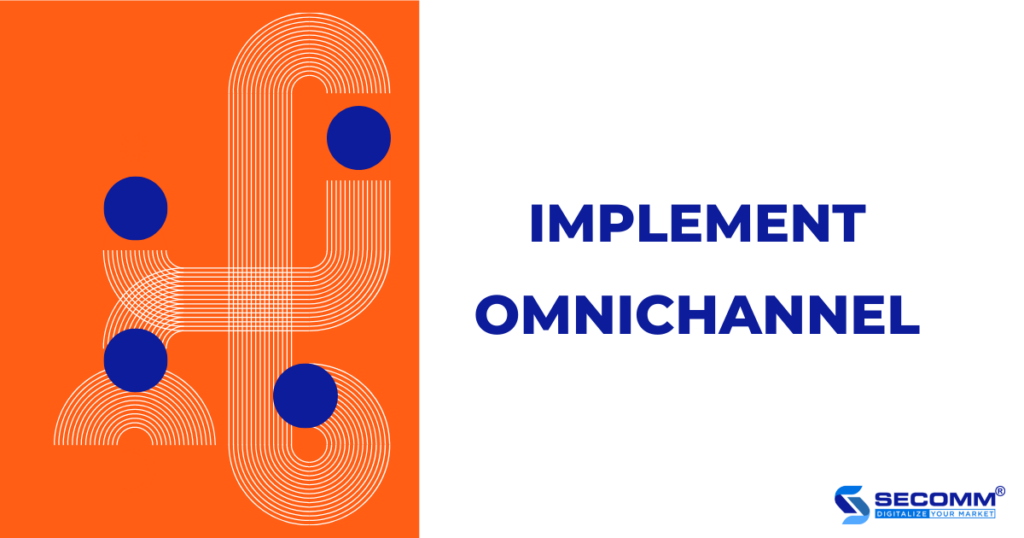
Omnichannel implementation process:
Most eCommerce websites require customers to create an account before making a purchase. This allows businesses to store the customer’s purchase history, delivery address for demographic analysis, purchase behavior assessment, sales analysis, and incentive to buy next time through Marketing campaigns.
Regular customers, in particular, will be willing to do this to reap the benefits of having an account on the website, such as quickly saving information for the next purchase or receiving notifications about upcoming big promotions. However, not all customers want to register for an account to purchase products.
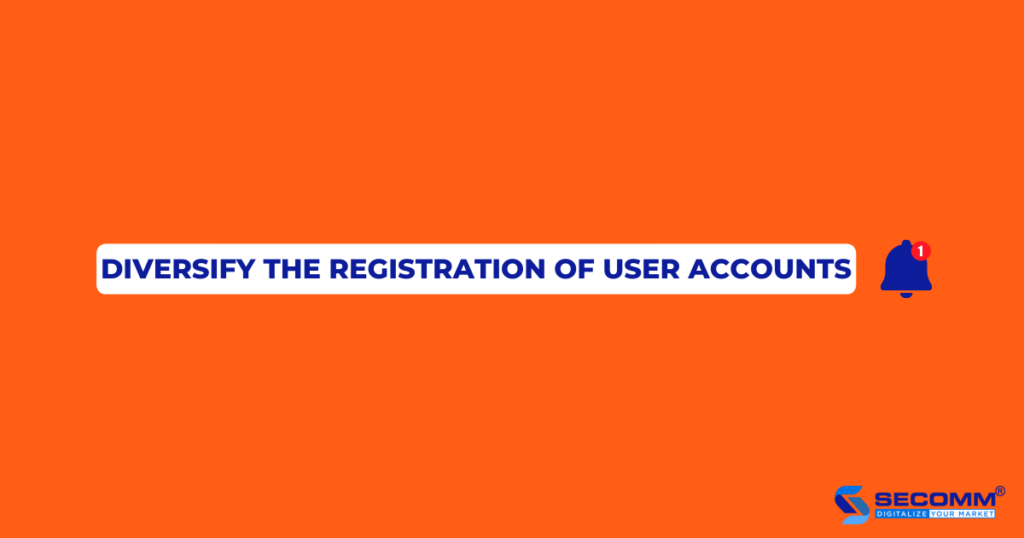
Therefore, businesses must provide options for customers who want to buy goods without registering an account, such as requiring customers to log in with a social network account or fill out a small payment form with their name, email, phone number, and address to complete the purchase process.
The eCommerce website system will automatically create an account and submit guest email login information in both cases.
Even on websites that do not sell anything, users frequently use the search bar. For businesses with eCommerce websites, the search bar must provide advanced search functionality.
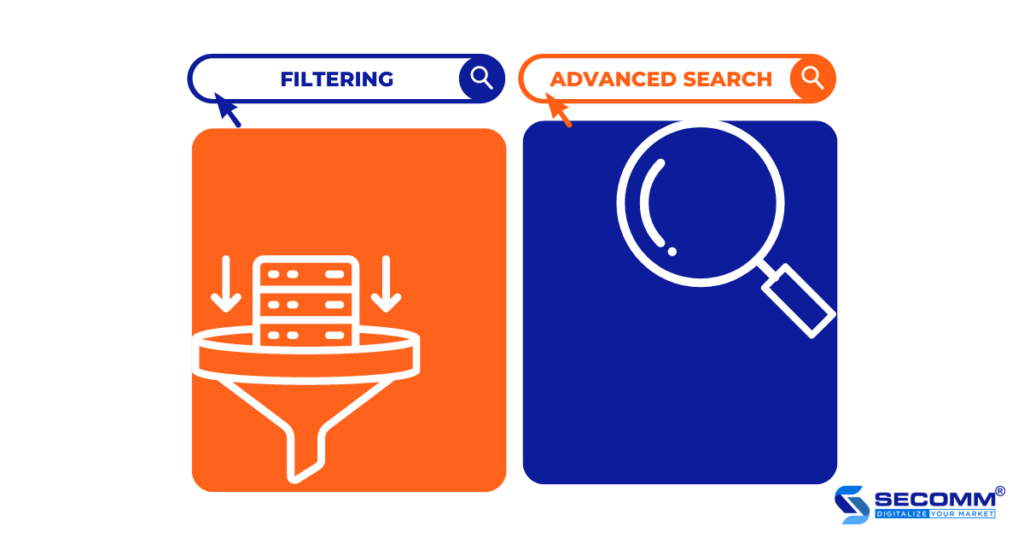
The image search feature, for example, allows users to upload a photo of a favorite item and have the eCommerce website’s search engine return products that are the same, nearly identical, or similar to the product the customers are looking for.
If users don’t know what to look for and need some suggestions, they should browse the website’s product categories. In these cases, the multi-layered product catalog function is extremely useful. In other cases, customers already have search objectives; a search bar with advanced support functions will also assist customers in finding the products they require with a few clicks.
Because online shopping and payments are becoming incredibly popular, it is critical to provide the appropriate payment options when developing an eCommerce website. According to the Payment Methods Report 2019, many shoppers abandon shopping carts because of delivery costs (55%) and complicated checkout processes (26%).
As a result, depending on the product and market that the company is targeting, the company will select a payment method that is appropriate for customers, products, and regions. The most popular payment methods in North America, according to Hostgator, are PayPal, Amazon Pay, Google Pay, Apple Pay, Visa or MasterCard, and so on.
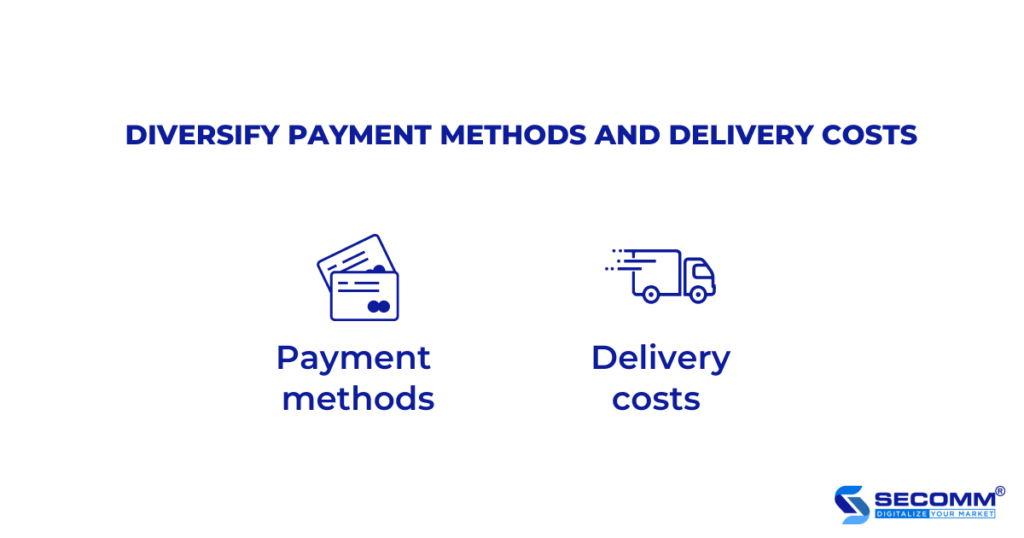
MoMo, Zalo Pay, Shopee Pay, Visa or MasterCard, and others will be particularly popular in the Vietnam market.
Furthermore, businesses should consider delivery costs because this is one of the primary reasons why customers abandon the purchasing process. Businesses can deploy flexible free shipping offers on special promotions, or if customers are required to pay shipping fees, the system should provide detailed information to avoid confusion and create a bad customer experience.
A content management system (CMS) allows you to centrally store and manage your written, visual, and document content. Businesses can change or add information, and the changes will be reflected on the eCommerce website. CMS can also help staff respond more quickly to customer feedback.
Most Internet shoppers are Millennials, Gen Y, and Gen Z. These generations value personalization, such as personalized recommendations, recommendations, or solutions from the support team.
Many eCommerce businesses are trying to meet this, the customer care department will help buyers solve problems during the purchase, payment, delivery, returns, complaints, and so on.
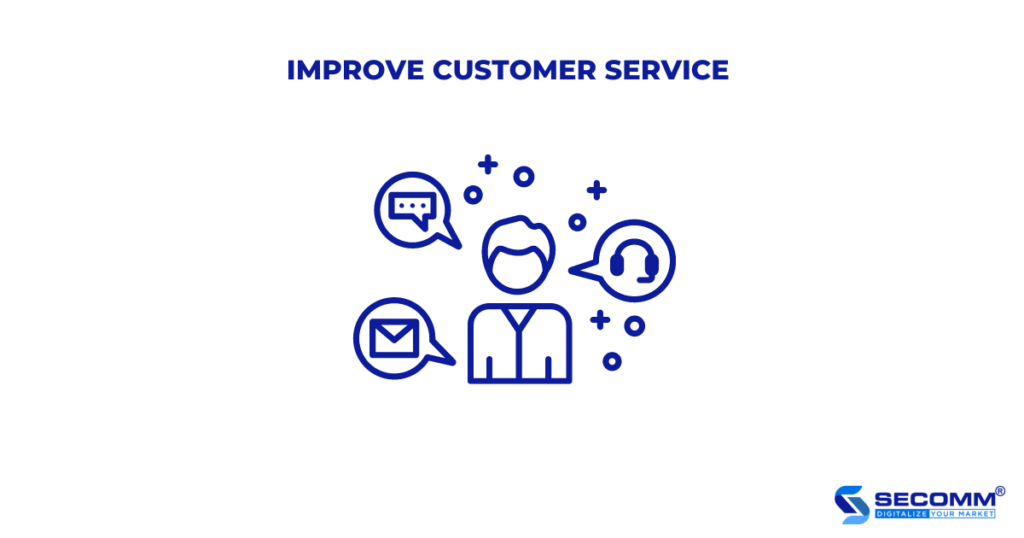
Furthermore, businesses should add a contact section to their eCommerce website with a hotline number or email that can be easily clicked or linked to the Facebook Messenger application, Zalo, live chat for orders, and general support chat for those who prefer this method of communication.
Businesses will be responsible for storing large amounts of user data and product information on an eCommerce website, so safety and security are the most important factors for any eCommerce website. Any negligence can put the company in danger of permanent data loss, and customer information can be stolen and sold.
Google and other search engines will flag an eCommerce website if it is deemed unsafe and has poor security, such as no SSL certificate and HTTPS protocol. This is considered a warning or recommendation for Internet users to be cautious about accessing websites that lack the above two components, as a result of which businesses will easily lose a large number of potential orders, causing marketing disruption and affecting the brand’s reputation.
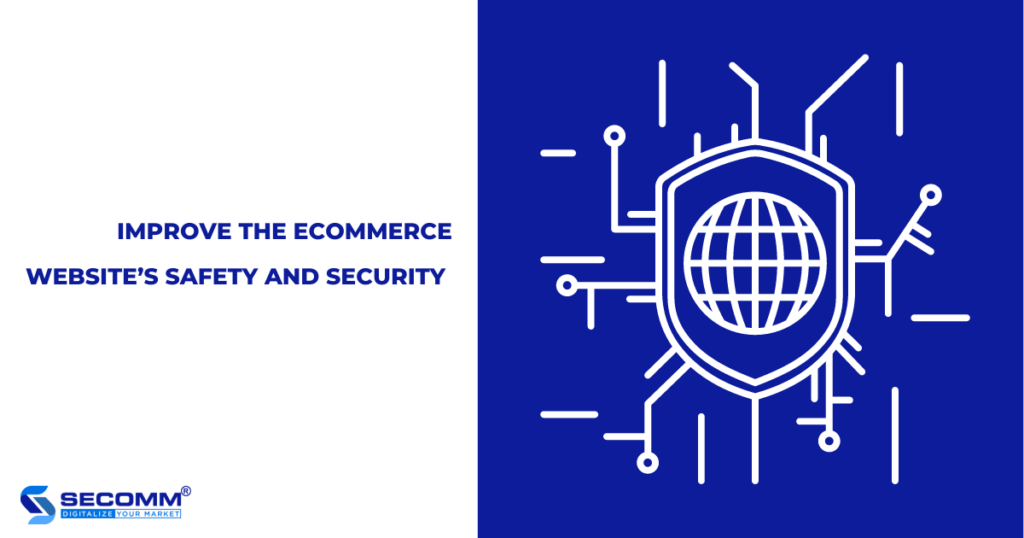
Furthermore, businesses must register an eCommerce website with the Ministry of Industry and Trade at the eCommerce Management Portal to demonstrate the website’s transparency following Vietnamese Government Decree 52/2013 ND-CP.
The 10 essential factors listed above are those that businesses must consider when implementing eCommerce. In reality, even when businesses use WordPress, the Woocommerce plugin, or a SaaS platform like Shopify, it is not easy to create an eCommerce website with full features that work well to attract customers. If your business decides to hire a website development company, that company must be capable of creating a comprehensive eCommerce website in terms of both design and functionality.
With many years of experience implementing eCommerce in many countries, SECOMM provides free consulting services with professional eCommerce solutions.
Contact us today for free support and advice!
 2
2
 4,604
4,604
 0
0
 1
1Subscribe to get the latest eBook!
Hotline